#CORRECTION: 2021 not 2020
Photo

Talulah
#arknights#talulah#talulah artorius#fanart#found this in my 2020 doodle folders and added to it#a follower on twitter requested this at the time when i asked ppl to give me suggestions for fun#CORRECTION: 2021 not 2020#also additive yes i play AK but I'm kinda transient and disappear some months but am super active other months#one more lvl to doctor lvl 120...
380 notes
·
View notes
Photo

gammermon
#digimon#digimon ghost game#ghost game#gammamon#2023#jesus christ i wrote 2020 and then corrected it to 2021 and then corrected it to 2022 and then corrected it to 2023#apologies for minimal art posts i have been sad#pluto art
392 notes
·
View notes
Text


^ Images taken before the fall
#well. at least i know myself#he's blorbo material alright i wasn't wrong on that count#i think i should have been scared of those books for other reasons though (psychological damage)#the funniest bit of me and hornblower lore is that the first hornblower tag on this blog was a 'let me assign you a boat media'#quiz that i took back in 2020 or 2021 i think (possibly even pre-pandemic). and you'll never guess who i got assigned#i had no idea who this guy was but also that was probably correct#perce rambles#percy yells at cecil scott
16 notes
·
View notes
Text
me six months ago when my therapist of 2 years said a schizoaffective diagnosis would be more appropriate than a bipolar diagnosis:
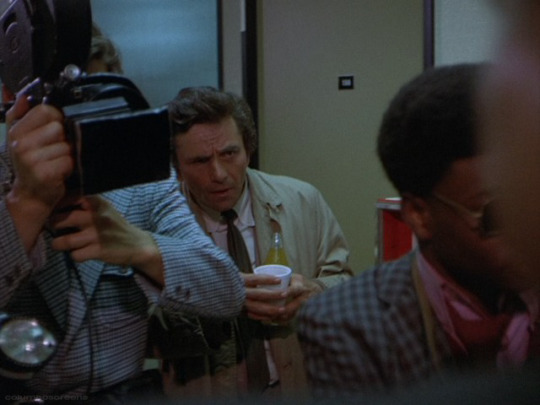
me currently, as i experience gradually worsening psychotic episodes without any mood shifts:
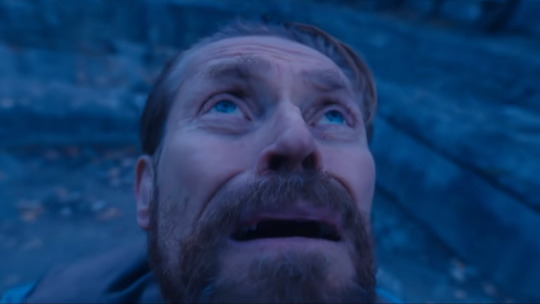
#the kicker is that. the first ever therapist i had back in 2019 theorized i was schizophrenic#like she . said . hey girl. i think youre schizo or bipolar#& back then we all thought it was the pot i was smokin#so it was diagnosed as bipolar ii#2020 rolls around & Oh Boy . get hospitalized in early jan 2021#bipolar i with psychotic features <- new diagnosis#but again . we thought it was the pot i was smoking#quit the pot . i start seein my then therapist#shes great i stick with her for 2 years . dont have any drastic mood shifts except depression#no mania . she thinks the depression is enviornmental based (turns out to be true)#however . she notices that . the Anxious Thought Patterns are . well . ocd#which is what the hospital staff had said#however . she also began to see that . they were psychotic#so . she told me toward the end that schizoaffective would be more fitting#well . im out of the bad enviornment i dont smoke pot anymore and yet . i am still losing my mind#she may have been . correct
5 notes
·
View notes
Text
if i get into a Little borderlands fixation bc of me getting around to playing bl3 im sorry but also i need something before i do another bg3 playthrough. but also ive missed this world soooo much. there's an oc potentially brewing. but as always im just sitting here bisexualiing it up about so many ppl in this game,,,,
#im still going !? that this game came out in 2019#you could have told me it came out in 2020/2021 and i would have been like yeah! that's correct!#and i even watched the like. first reveal of game whenever it came out. so like. i knew when it came out#i also have no idea how long it was sitting in my epic games accnt bc i know i got it for free but that's all#i just was too lazy to wait the entire day it takes my internet to install 100 gigs of game
4 notes
·
View notes
Text
the sweetest vindication i have ever fucking tasted
#oh how lovely it is to be correct about media#rising my glass to the 2020 and 2021 c!inniters when we were fully in the trenches. we have been avenged my brethren#alex.rambles.txt#c!tommy#mcyt
5 notes
·
View notes
Text
I was reading this really good book (and I don't say that lightly. I'm super critical of books), and it was published in 2021, but it kept mentioning Goncharov? This was starting to mess with me a bit, especially since I was reading a hardcopy used book. I'm thinking, the timelines don't match for it to be a reference, but that word didn't exist before tumblr did all that, right? The book also deals with the concept of reality, so it was a bit coincidental. But for whatever reason I was determined to finish the book before I investigated.
Well, I just finished and turns out Ivan Goncharov was a real writer and I feel ignorant and uncultured.
Anyway, I really recommend The Anomaly by Hervé le Tellier. I'm trying to regain my fluency so I read the first 40% in French, but then I got impatient and switched to English. Disappointingly very American-centric though, so reading the original French didn't add too much I don't think.
#Don't read it if you have issues with unreality though!#It was obviously written before the 2020 election#and it's set in 2021#But all the inconstencies with real life are actually very fitting#given the subject matter#The one funny translation difference is that characters would often say#C'est dingue !#Which they translated to#That's nuts!#Which is correct but feels cornily out of place in context#The Anomaly#L'anomalie
1 note
·
View note
Text
scott street
boyfriend! chris sturniolo x reader
summary: subscribers are convinced chris and his girlfriend broke up so they start making sad edits.
warnings: swearing, kissing, pet names (baby, ma, mama), mentions of y/n.
a/n: randomly got this idea, enjoy and please please read the author’s note at the end !! <3
november 1, 2020
halloween vlog with mom and y/n
“okay so, we have another special guest for todays video. chris’ girlfriend y/n!” nick exclaims as chris’ hand wraps around y/n from behind and rests on her stomach. y/n just smiles and waves at the camera.
february 12, 2021
guess the triplet by zoomed in pictures !!!
“chris wants to see if y/n can get some right so she’s gonna just go for fun.” matt explains as y/n moves to sit in front of the camera. chris stands behind her.
“alright.” nick says, turning his phone around to show a picture of someone’s hair. y/n squints her eyes to try and see the picture.
after a few seconds she giggles. “matt.”
“correct. next one.” nick smiles, swiping to the next picture.
the next picture showed an arm but in the corner of the picture you could see a little bit of a red t-shirt.
she immediately gasps. “chris! that’s chris.”
“how did you get that!” chris asks, his mouth open slightly.
“the red shirt. that was our first date and our first picture.” she tells him, looking up at him from her chair.
“well it’s safe to say y/n can tell us apart.” nick says, grabbing the camera.
june 25, 2021
baking pizza blindfolded with chris
“chris!” y/n giggles as chris starts playing with the flour on the counter.
“what baby?” he asks, laughing as well.
“stop playing with the flour.” she tells him as matt stands on the other side of chris.
march 4, 2024
sturniololvr
liked by 43,929
sturniololvr - i miss them.
12,741 comments
user - the last video she was in was the everyone relax video 😔
march 6, 2024
y/n ❤️:
*attachment one video*
this one has a little kick to it
chris baby 🫶:
y/n/n please stop sending me break up edits of us we’re literally still together.
y/n ❤️:
IM SORRY BABY BUT THEYRE LITERALLY EVERYWHERE
may 17, 2023
“chris can we talk?” y/n asks. chris’ mind immediately starts running millions of miles a minute. he thought she was breaking up with him.
“no!” he quickly exclaims. y/n gasps, realizing what was going through his mind.
“no baby i’m not breaking up with you.” she tells him.
“oh okay then yes we can talk.” he nods, walking closer to her, their chests almost touching.
“is it okay if i’m not really in the videos anymore? i really love being in them with you guys but the fans have gotten to be too much. i’ve tried to ignore them.” she tells him softly. chris’ face softens.
“of course, yeah. i’ll tell nick and matt in the morning.” chris nods softly.
“i’m sor-“ she begins to apologize.
“don’t even think about apologizing. i understand and i know that nick and matt will understand too. c’mere.” he says, pulling her into him.
march 13, 2024
chris makes matt and nick his favorite meal
“chris do you think i could be in today’s video? even for just like a second. i don’t like people thinking that we broke up.” y/n asks softly, just before the triplets were about to film a wednesday video.
“yeah mama, you’re always allowed in a video.” chris nods, a smile on his face.
“y/n come get your plate!” chris smiles at his girlfriend who was sitting in the living room. a happy smile spreads on her face as she walks into the view of the camera to grab the plate out of chris’ hand.
“thank you.” she smiles, quickly pecking his lips before walking back to the living room. she would usually eat at the table but the boys were currently using the table.
a smile stayed on y/n’s face as she scrolled through all the comments the newest video.
user - Y/N BABY
user - i can die happily knowing they’re still together
user - y’all are crazy
user - i missed her 😕😕
user - FAVVVVVV COUPLE THEYRE SO CUTE
a/n: hey guys !! sorry for being so inactive, this year has been so so crazy. for starters, i lost my great grandmother january first, and then i lost my great grandfather on february twenty third. a few months later, my older brother attempted and was put into a hospital, and now my grandfather has cancer that spread to his lungs and brain. on top of everything, i’ve been preparing for my aunt’s wedding (i’m a bridesmaid) and everything has been super stressful. i wanted to post something and let you guys know that i’ll be taking a break to take time for myself and to spend time with my family. i’ll still be lurking around on the app, commenting, reblogging, etc, i just won’t be posting any fics for a little while.
i hope you can all understand and i love you all <3 <3 <3
#chris sturniolo#sturniolo triplets#matt sturniolo#nick sturniolo#chris sturniolo x reader#sturniolo fanfic#sturniolo fandom#sturniolo x reader#spotify
1K notes
·
View notes
Text
#NSG 6001 Final Exam / NSG6001 Final Exam#Latest 2020/2021 South University / 100% Correct Answers#Download to Score A
0 notes
Text
fuck it transition timeline
I was originally gonna wait until July to do this because that'll mark 3 years on E but I feel like now's a good time all things considered
With that out of the way lets start from the beginning AKA freshman year (AKA 2018)
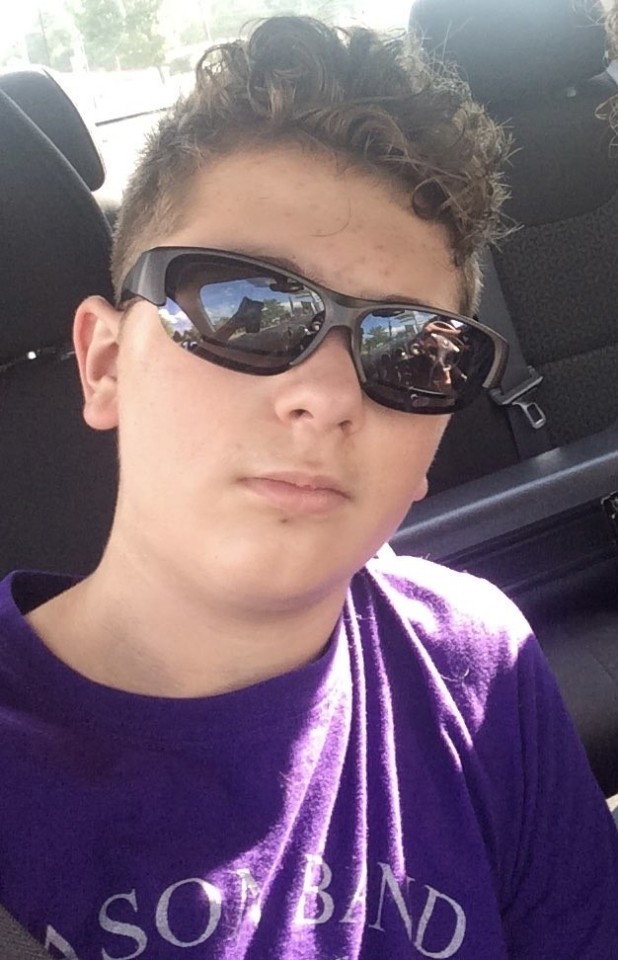
This was on my way to band camp which is why you can see my trombone in the background (random fact: that was the only year I got to do marching band and our show was "the music of harry potter". yeah irony's a bitch ain't she?)
Graduation picture featuring the bestest boi Jinn :3
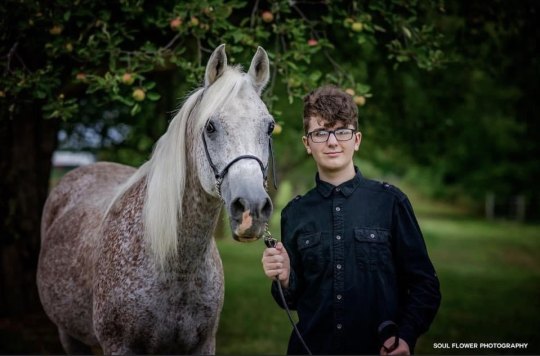
This pic is from 2020 because I switched to online and finished high school early out of spite (I was 16 here if you were wondering)
Now then this is from 2021 and was taken only about a week before I started hrt when I was 17

The lake in the background is Lake Superior in case you were wondering. Me and my mother were all the way up on the Keweenaw Peninsula for my family's 4th of July party held at the family farm
Moving on from that I started HRT on July 22 2021 (the appointment was at 9:30 am and I took my first dose at 7:42 pm yes I kept track)

This was taken like a half hour after my first dose (I actually don't really like this pic that much but I'm including it because it is important)
Fast forward from that a year to 2022 when I was 18 and here are a few pics of me around then one of which again featuring best boi Jinn

(it was windy out that day and he tried to bite me immediately after this lmao)



I've never been particularly good at taking selfies lmao
That brings us to now. I've been on hrt for about 2.5 years now if my math is correct. I'm pretty much living full time as a woman, started laser hair removal a couple months ago (next apt is actually tomorrow lol), and I'm working on getting my legal name and gender changed. It's been a long ride thus far and I don't really plan on stopping anytime soon so yeah here ya go




So that's it! At least thus far lol
also fuck photomatt 🚗🔨💥
#Trans#Transgender#transition timeline#queer#lesbian#long post#I might have gotten a little bit carried away there lol#🚗🔨💥#idgaf if this is cheesy or whatever#I kinda like how it turned out#took too long to gather all these together#I like never take pics of myself#my camera roll is just 4000 memes
556 notes
·
View notes
Text
define: states 🫶
also known as: how to manifest using states!

your state is what manifests, not your thoughts.
this has become a very inflammatory sentence for some, but it shouldn't be scary. states simplify manifestation, it doesn't complicate it.
at the beginning of my loa journey, i would affirm alllll day long. while watching tv, while reading, while hanging out with my friends. and by the logic of "your dominant thoughts manifest," i should've gotten my manifestations after only a few days of that. but i didn't, because dominant thoughts aren't what manifests, it's your state that manifests.
you are not a state. you are I Am, and you enter in and out of states all day long. there is an infinite number of states, and no one experiences states the same way. so even if two people are manifesting the same thing (for example, money), the State of Being Rich will probably look different for both of them. so there's really no one specific way a state should look/feel!
because there are an infinite number of states you can occupy, right now you have the power to be rich, just as much as you have the power to be poor. it is just as easy to occupy the state of being rich as it is the state of being poor. you are both of these things, and you know that you are both of these things because you can imagine being both of these things, and everything stems from your imagination.
the state that you consistently go to, also known as your dwelling state, is the state that manifests into your 3d reality.
so, how do you get into a state?
you switch states simply by intending to. the second you want to switch states, you do. in order to maintain this new state, you can use a technique such as affirming, scripting, or visualizing.
let's talk about affirming.
affirming is a TECHNIQUE. some people argue that since affirmations are just thoughts, you can never stop affirming and should be monitoring your thoughts all day long. i do not agree with this.
your thoughts do not manifest. it's why i spent my time from summer 2020-summer 2021 affirming on a constant loop 24/7 that i was in a relationship with my [old] sp, and it never manifested. it's why when you get intrusive thoughts they don't manifest. it's why--even tho every time you go to the bathroom you check behind the shower curtain in case something's there--nothing ever is. it's also why you were able to manifest something by thinking you wanted it once.
you do not need to "create new neural pathways" or think in your favor 24/7. your negative thoughts act as indicators that you fell out of your desired state, and you can instantly correct this by shifting back to the state of the wish fulfilled. you don't even need to flip the thought. your thoughts have no power, unless you give them power by allowing them to let you wallow in the state of lack.
all that being said, affirmations can help you maintain your desired state. i say maintain, because getting into the state is instant, and requires no technique. however, there is such thing as affirming from lack.
what is affirming from lack? it's affirming to get what you want. it's affirming from a state of not having your desire. it's the same as thinking of your desire, instead of thinking from your desire.
a few months ago, the 10k challenge was going around. it was marketed as a fool-proof way to get your manifestation, because all you had to do was "affirm 10k times to create a new neural pathway which created an assumption." yet so many people affirmed 10k+ times and still didn't get their desire. why? because they were affirming from lack.
quality > quantity. you can affirm 10k times and not get your desire, because you weren't in your desire state. you can affirm once and get your desire, because you were in the state.
so how do you not affirm from lack?
an easy way is to pay attention to your affirmations. mindless affirming is out! this shouldn't be a scary thing to hear, because as we discussed, there's no need for you to affirm 5 million times in order to reach some imaginary quota, because your thoughts don't manifest.
affirm with purpose! create an affirmation that implies you already have your desire, and repeat it with the purpose of conjuring the feeling of knowing. the feeling of knowing may feel like calm, peace, relief, contentment, or even excitement. when Neville Goddard said "feeling is the secret," this is the feeling he was talking about, NOT emotions.
if your affirmations are making you feel anxious, this can indicate one of two things:
affirming is not the technique for you (which is OKAY!!)
you're affirming to get
"affirming to get" is a big debate as well. yes, you are manifesting your desire because you want to get it in your 3D. but in order to get it in your 3D, you must change your 4D first. so you should be using techniques such as affirming in order to change your 4D, knowing that if you change your 4D, your 3D will follow. there is no one to change but self.
if affirming is not the technique for you, there is always visualizing, scripting, vaunting, etc.
also the distraction technique, my fav way to get into the state of the wish fulfilled! hehe
to sum it up:
"it's not focusing so much on getting the objects, but becoming the one who already has it." - Edward Art
where does persisting come in?
you should still be persisting in the fact that you already have your desire. you persist by consistently shifting back to your desired state, no matter what you see in the 3D.
reacting to the 3D, like negative thoughts, is an indicator that you have slipped from your desired state.
it can be very beneficial for you to have self-soothing tactics to use in case your 3D causes you to spiral or makes you anxious. these can include eft tapping, breathing exercises, etc.
your 3D is malleable. if you see something in your 3D that you don't like, you can change it. your 3D is simply a reflection of your dwelling state. if you don't see what you want in your 3D, let it serve as a reminder to shift your state back to your desired state. once again, you change your 4D to change your 3D. there is no one to change but self.
FAQ
question: if you can affirm to get into a state, doesn't that mean your thoughts create your state and that your thoughts technically manifest?
answer: WRONG! like i've mentioned earlier in this post, you enter a state by intention. affirming can help you maintain the state, but your thoughts do not create your state. your state creates your thoughts. every state has thoughts that correspond with it, which is why can manufacture affirmations that imply you already have your desire and repeat them to conjure the feeling of knowing. it's also why negative thoughts act as indicators that you fell out of the state.
question: isn't that the same as someone saying "just assume?"
answer: NO! there are techniques to help you maintain the state. yes entering a state is instant, but there are techniques for you to use to stay in it.
question: are states ableist?
answer: NO!!!! this is something that people are saying on loatwt in order to villainize the people who teach states, and it's frankly disgusting. ANYONE can get into a state, even if they are neurodivergent! you are always in a state! you're in a state right now. i am neurodivergent, as are most of my friends that are states enthusiasts, and it has helped all of us to manifest our desires without driving ourselves to mental exhaustion by affirming 24/7.
question: how long do i have to stay in the wish fulfilled?
answer: it's not so much about how long you stay in the state, it's about frequency. no, not frequency as the law of attraction vibration bullshit, but how often you go back to the state. if you think about your desire 15 times a day, you should shift back into the state 15 times that day. if you think about your desire 5 times, then you should shift back into the state 5 times that day.
hopefully this helps clarify the idea of states for you, and helps you manifest your desires!! <3

3K notes
·
View notes
Text
Dragon Age: The Veilguard GameInformer Article Transcribed
I saw some people lamenting that they had no way to read the GameInformer article, and while MVP dalishious posted screenshots of the article here, I figured that might be a little difficult to read, plus people with screen readers can't read it of course. So I've gone ahead and transcribed it! Full thing below the cut!
As a note, I transcribed it without correcting any typos, capitalization errors, etc. that the article itself had (as much as it pained me, omg the author capitalizes so many things that shouldn't be and vice versa). There may be some typos on my part as I did this as quickly as I could, so apologies in advance for any you might encounter.
I have also created a plot-spoiler-free version of the article for those who would like to learn more about the mechanics of the game without learning more plot info than they want!
Throughout my research and preparation for a trip to BioWare’s Edmonton, Canada, office for this cover story, I kept returning to the idea that its next game, Dragon Age: The Veilguard (formerly subtitled Dreadwolf) is releasing at a critical moment for the storied developer. The previous installment, Dragon Age: Inquisition, hit PlayStation, Xbox, and PC a decade ago. It was the win BioWare needed, following the 2012 release of Mass Effect 3 with its highly controversial and (for many) disappointing ending. Inquisition launched two years later, in 2014, to rave reviews and, eventually, various Gameo the Year awards, almost as if a reminder of what the studio was capable of.
Now, in 2024, coincidentally, the next Dragon Age finds itself in a similar position. BioWare attempted a soft reboot of Mass Effect with Andromeda in 2017, largely seen as a letdown among the community, and saw its first live-service multiplayer attempt in 2019’s Anthem flounder in the tricky waters of the genre; it aimed for a No Man’s Sky-like turnaround with Anthem Next, but that rework was canceled in 2021. Like its predecessor, BioWare’s next Dragon Age installment is not only a new release in a beloved franchise, but is another launch with the pressure of BioWare’s prior misses; a game fans hope will remind them the old BioWare is still alive today.
“Having been in this industry for 25 years, you see hits and misses, and it’s all about building off of those hits and learning from those misses,” BioWare general manager Gary McKay, who’s been with the studio since January 2020, tells me.
As McKay gives me a tour of the office, I can’t help but notice how much Anthem is scattered around it. More than Mass Effect, more than Dragon Age, there’s a lot of Anthem - posters, real-life replicas of its various Javelins, wallpaper, and more. Recent BioWare news stories tell of leads and longtime studio veterans laid off and others departing voluntarily. Veilguard’s development practically began with the COVID-19 pandemic in 2020. When I ask McKay about the tumultuousness of BioWare and how he, as the studio manager, makes the team feel safe in the product it’s developing, he says it’s about centering on the creative vision. “[When] we have that relentless pursuit for quality, and we have passion and people in the right roles, a lot of the other stuff you’re talking about just fades into the background.”
That’s a sentiment echoed throughout the team I speak to: Focus on what makes a BioWare game great and let Veilguard speak for itself. Though I had no expectations going in - it’s been 10 years since the last Drag Age, after all, and BioWare has been cagey about showing this game publicly - my expectations have been surpassed. This return to Thedas, the singular continent of the franchise, feels like both a warm welcome for returning fans and an impressive entry point for first-time players.
New Age, New Name
At the start of each interview, I address a dragon-sized elephant in the room with the game’s leads. What was Dragon Age: Dreadwolf is now Dragon Age: The Veilguard. Why?
“These games are reflections of the teams that make them, and as part of that, it means we learn a lot about what the heart and soul of the game really is as we’re developing it,” Veilguard game director Corinne Busche tells me. “We quickly learned and realized that the absolute beating heart of this game is these authentic, diverse companions. And when we took a step back, as we always do, we always check our decisions and make sure they still represent the game we’re trying to build.”
Dreadwolf no longer did that, but each member of BioWare I speak to tells me The Veilguard does. And while I was initially abrasive to the change - lore aside, Dreadwolf is simply a cool name - I warmed up to The Veilguard.
Solas, a Loki-esque trickster member of the Elven pantheon of gods known as the Dread Wolf, created the Veil long ago while attempting to free the elves from their slave-like status in Thedas. This Veil is a barrier between the magical Fade and Thedas, banishing Elven gods and removing Elven immortality from the world. But players didn’t know that in Inquisition, where he is introduced as a mage ally and companion. However, at the end of Inquisition’s Trespasser DLC, which sets the stage for Veilguard, we learn in a shocking twist that Solas wants to destroy the Veil and restore Elves to their former glory. However, doing so would bring chaos to Thedas, and those who call it home, the people who eventually become The Veilguard, want to stop him.
“There’s an analogy I like to use, which is, ‘If you want to carve an elephant out of marble, you just take a piece of marble and remove everything that doesn’t look like an elephant,’” Veilguard creative director John Epler says. “As we were building this game, it became really clear that it was less that we were trying to make The Veilguard and more like The Veilguard was taking shape as we built the game. Solas is still a central figure in it. He’s still a significant character. But really, the focus shifts to the team.
“[We] realized Dreadwolf suggests a title focused on a specific individual, whereas The Veilguard, much like Inquisition, focuses more on the team.”
Creating Your Rook
Veilguard’s character creator is staggeringly rich, with a dizzying number of customizable options. Busche tells me that inclusivity is at the heart of it, noting that she believes everyone can create someone who represents them on-screen.
There are four races to choose from when customizing Rook, the new playable lead - Elves, Qunari, Humans, and Dwarves - and hundreds of options to customize your character beyond that. You can select pronouns separately from gender and adjust physical characteristics like height, shoulder width, chest size, glute and bulge size, hip width, how bloodshot your eyes are, how crooked your nose is, and so much more. There must be hundreds of sliders to customize these body proportions and features like skin hue, tone, melanin, and just about anything else you might adjust on a character. Oh, and there’s nudity in Veilguard, too, which I learn firsthand while customizing my Rook.
“The technology has finally caught up to our ambition,” Dragon Age series art director Matt Rhodes tells me as we decide on my warrior-class Qunari’s backstory, which affects faction allegiance, in-game dialogue, and reputation standing - we choose the pirate-themed Lords of Fortune.
Notably, instead of a warrior class, we could have chosen mage or rogue. All three classes have unique specializations, bespoke skill trees, and special armors, too. And though our Rook is aligned with the Lords of Fortune faction, there are others to choose from including the Grey Wardens, Shadow Dragons, The Mourn Watch, and more. There is some flexibility in playstyle thanks to specializations, but your class largely determines the kind of actions you can perform in combat.
“Rook ascends because of competency, not because of a magical McGuffin,” BioWare core lead and Mass effect executive producer Michael Gamble tells me in contrast to Inquisition’s destiny-has-chosen-you-characterization.
“Rook is here because they choose to be, and that speaks to the kind of character that we’ve built.” Busche adds, “Someone needs to stop this, and Rook says, ‘I guess that’s me.’”
Beyond the on-paper greatness of this character creator, its customizability speaks to something repeated throughout my BioWare visit: Veilguard is a single-player, story-driven RPG. Or in other words, the type of game that made BioWare as storied as it is. McKay tells me the team explored a multiplayer concept early in development before scratching it to get back to BioWare basics. The final game will feature zero multiplayer and no microtransactions.
Happy to hear that, I pick our first and last name, then one of four voices, with a pitch shifter for each, too, and we’re off to Minrathous.
Exploring Tevinter For The First Time
Throughout the Dragon Age series, parts of Thedas are discussed by characters and referenced by lore material but left to the imagination of players as they can’t visit them. Veilguard immediately eschews this, setting its opening prologue mission in Minrathous, the capital of the Tevinter Empire. Frankly, I’m blown away by how good it looks. It’s my first time seeing Veilguard in action and my first look at a Dragon Age game in nearly a decade. Time has treated this series well, and so has technology.
Epler, who’s coming up on 17 years at BioWare, acknowledges that the franchise has always been at the will of its engine. Dragon Age: Origins and II’s Eclipse Engine worked well for the time, but today, they show their age. Inquisition was BioWare’s first go at Ea’s proprietary Frostbite engine - mind you, an engine designed for first-person shooters and decidedly not multi-character RPGs - and the team struggled there, too. Epler and Busche agree Veilguard is the first RPG where BioWare feels fully in command of Frostbite and, more generally, its vision for this world.
We begin inside a bar. Rook and Varric are looking for Neve Gallus, a detective mage somewhere in Minrathous. The first thing players will do once Veilguard begins is select a dialogue option, something the team says speaks to their vision of a story-forward, choice-driven adventure. After a quick bar brawl cutscene that demonstrates Rook’s capabilities, there’s another dialogue choice, and different symbols here indicate the type of tone you can roll with. There’s a friendly, snarky, and rough-and-tough direct choice, and I later learn of a more romantically inclined “emotional” response. These are the replies that will build relationships with characters, romantic and platonic alike, but you’re welcome to ignore this option. However, your companions can romance each other, so giving someone the cold shoulder might nudge them into the warm embrace of another. We learn Neve is in Dumat Plaza and head into the heart of Minrathous.
Rhodes explains BioWare’s philosophy for designing this city harkens back to a quick dialogue from Inquisition’s Dorian Pavus. Upon entering Halamshiral’s Winter Palace, the largest venue in Dragon Age history at that point, Dorian notes that it’s cute, adorable even, alluding to his Tevinter heritage. If Dorian thinks the largest venue in Dragon Age history is cute and adorable, what must the place he’s from be like? “It’s like this,” Rhodes says as we enter Minrathous proper in-game.
Minrathous is huge, painted in magical insignia that looks like cyberpunk-inspired neon city signs and brimming with detail. Knowing it’s a city run by mages and built entirely upon magic, Rhodes says the team let its imagination run wild. The result is the most stunning and unique city in the series. Down a wide, winding pathway, there’s a pub with a dozen NPCs - Busche says BioWare used Veilguard’s character creator to make each in-world NPC except for specific characters like recruitable companions - and a smart use of verticality, scaling, and wayfinding to push us toward the main attraction: Solas, attempting to tear down the Veil.
All hell is breaking loose. Pride Demons are rampaging through the city. Considering Pride Demons were bosses in prior games, seeing them roaming freely in the prologue of Veilguard speaks to the stakes of this opener. Something I appreciate throughout our short journey through Minrathous to its center below is the cinematography at play. As a Qunari, my character stands tall, and Rhodes says the camera adjusts to ensure larger characters loom over those below. On the flip side, the camera adjusts for dwarves to demonstrate their smaller stature compared to those around them.
This, coupled with movie-liked movement through the city as BioWare showcases the chaos happening at the hands of Solas’ Veil-break ritual, creates a cinematic start that excited me, and I’m not even hands-on with the game.
Eventually, we reach Neve, who has angered some murderous blood mages, and rescue her from danger. Or rather, help… barely. Neve is quite capable, and her well-acted dialogue highlights that. Together, Varric, returning character Lace Harding, who is helping us stop Solas and is now a companion, Rook, and Neve defeat some demons. They then take on some Venatori Cultists seizing this chaotic opportunity to take over the city and other enemies before making it to Solas’ hideout. As we traverse deeper and deeper into this hideout, more of Solas’ murals appear on the walls, and things get more Elven. Rhodes says this is because you’re symbolically going back in time, as Minrathous is a city built by mages on the bones of what was originally the home of Elves.
At the heart of his hideout, we discover Solas’ personal Eluvian. This magical mirror-like structure allows the gang to teleport (and mechanically fast-travel) to Arlathan Forest, where Solas is secretly performing the ritual (while its effects pour out into Minrathous).
Here, we encounter a dozen or so demons, which BioWare has fully redesigned on the original premise of these monstrous creatures. Rhodes says they’re creatures of feeling and live and die off the emotions around them. As such, they are just a floating nervous system, push into this world from the Fade, rapidly assembled into bodies out of whatever scraps they find.
I won’t spoil the sequence of events here, but we stop Solas’ ritual and seemingly save the world… for now. Rook passes out moments later and wakes up in a dream-like landscape to the voice of none other than Solas. He explains a few drops of Rook’s blood interacted with the ritual, connecting them to the Fade forever. He also says he was attempting to move the Elgar’nan and Ghilan’nain, part of the Evanuris or Elven gods of ancient times, to a new prison because the one he had previously constructed was failing. Unfortunately, Solas is trapped in the Fade by our doing, and these gods are now free. It’s up to Rook to stop them; thus, the stage for our adventure is set.
The Veilguard Who’s Who
While we learned a lot about returning character but first-time companion Lace Harding, ice mage private detective Neve Gallus, and veil jumper Bellara Lutara, BioWare shared some additional details about other companions Rook will meet later in the game. Davrin is a charming Grey Warden who is also an excellent monster hunter; Emmrich is a member of Nevarra’s Mourn Watch and a necromancer with a skeleton assistant named Manfred; Lucanis is a pragmatic assassin whose bloodline descends from the criminal House of Crows organization; And Taash is a dragon hunter allied with the piratic Lords of Fortune. All seven of these characters adorn this Game Informer issue, with Bellara up front and center in the spotlight.
The Lighthouse
After their encounter with Solas, Rook wakes up with Harding and Neve in the lair of the Dread Wolf himself, a special magical realm in the Fade called the Lighthouse. It’s a towering structure centered amongst various floating islands. Epler says, much like Skyhold in Inquisition, the Lighthouse is where your team bonds, grows, and prepares for its adventures throughout the campaign. It also becomes more functional and homier as you do. Already, though, it’s a beautifully distraught headquarters for the Veilguard, although they aren’t quite referring to themselves as that just yet.
Because it was Solas’ home base of operations, it’s gaudy, with his fresco murals adorning various walls, greenery hanging from above, and hues of purple and touches of gold everywhere. Since it’s in the Fade, a realm of dreams that responds to your world state and emotion, the Lighthouse reflects the chaos and disrepair of the Thedas you were in moments ago. I see a clock symbol over a dialogue icon in the distance, which signals an optional dialogue option. We head there, talk to Neve, select a response to try our hand at flirting, and then head to the dining hall.
A plate, a fork and knife, and a drinking chalice are at the end of a massive table. Rhodes says this is both a funny (and sad) look at Solas’ isolated existence and an example of the detail BioWare’s art team has put into Veilguard. “It’s a case of letting you see the story,” he says. “It’s like when you go to a friend's house and see their bedroom for the first time; you get to learn more about them.” From the dining hall, we gather the not-quite-Veilguard in the library, which Busche says in the central area of the Lighthouse and where your party will often regroup and prepare for what’s next. The team decides it must reach the ritual site back in Arlathan Forest, and Busche says I’m missing unique dialogue options here because I’m Qunari; an Elf would have more to say about the Fade due to their connection to it. The same goes for my backstory earlier in Minrathous. If I had picked the Shadow Dragons background, Neve would have recognized me immediately, with unique dialogue.
With our next move decided, we head to Solas’ Eluvian to return to Arlathan Forest and the ritual site. However, it’s not fully functional without Solas, and while it returns us to Arlathan Forest, it’s not exactly where we want to go. A few moments later, we’re back in the Arlathan Forest, and just before a demon-infested suit of mechanized armor known as a Sentinel can attack, two new NPCs appear to save us: Strife and Irelin. Harding recognizes them, something Dragon Age comic readers might know about. They’re experts in ancient elven magic and part of the new Veil Jumpers faction. The ensuing cutscene, where we learn Strife and Irelin need help finding someone named Bellara Lutara, is long, with multiple dialogue options. That’s something I’m noticing with Veilguard, too - there’s a heavy emphasis on storytelling and dialogue, and it feels deep and meaty, like a good fantasy novel. BioWare doesn’t shy away from minutes-long cutscenes.
Busche says that’s intentional, too. “For Rook, [this story’s about] what does it meant to be a leader,” she says. “You’re defining their leadership style with your choices.” Knowing that Rook is the leader of the Veilguard, I’m excited to see how far this goes. From the sound of it, my team will react to my chosen leadership style in how my relationships play out. That’s demonstrated within the game’s dialogue and a special relationship meter on each companion’s character screen.
Redefining Combat Once More
Bellara is deep within Arlathan Forest, and following the prolgoue’s events, something is up here. Three rings of massive rocks fly through the air, protecting what appears to be a central fortress. Demon Sentinels plague the surrounding lands, and after loading up a new save, we’re in control of a human mage.
Following the trend of prior Dragon Age games, Veilguard has completed the series’ shift from tactical strategy to real-time action, but fret not: a tactical pause-and-play mechanic returns to satiate fans who remember the series’ origins (pun intended). Though I got a taste of combat in the prologue, Veilguard’s drastic departure from all that came before it is even more apparent here.
Busche says player complete every swing in real-time, with special care taken to animation swing-through and canceling. There's a dash, a parry, the ability to charge moves, and a completely revamped healing system that allows you to use potions at your discretion by hitting right on the d-pad. You can combo attacks and even “bookmark” combos with a quick dash, which means you can pause a combo’s status with a dash to safety and continue the rest of the combo afterward. It looks even cooler than it sounds.
Like any good action game, there is a handful of abilities to customize your kit. And, if you want to maintain that real-time action feel, you can use them on the fly, so long as you take cooldowns into effect. But Veilguard’s pause-and-play gameplay mechanic, similar to Inquisition’s without the floating camera view, lets you bring things to halt for a healthy but optional dose of strategy.
In this screen, which essentially pauses the camera and pulls up a flashy combat wheel that highlights you and your companions’ skills, you can choose abilities, queue them up, and strategize with synergies and combos, all while targeting specific enemies. Do what you need to here, let go of the combat wheel, and watch your selections play out. Busche says she uses the combat wheel to dole out her companions’ attacks and abilities while sticking to the real-time action for her player-controlled Rook. On the other hand, Epler says he almost exclusively uses the combat wheel to dish out every ability and combo.
Busche says each character will play the same, in that you execute light and heavy attacks with hte same buttons, use abilities with the same buttons, and interact with the combo wheel in the same way, regardless of which class you select. But a sword-and-shield warrior, like we used in the prolgoue, can hip-fire or aim their shield to throw it like Captain America, whereas our human mage uses that same button to throw out magical ranged attacks. The warrior can parry incoming attacks, which can stagger enemies. The rogue gets a larger parry window. Our mage, however, can’t parry at all. Instead, they throw up a shield that blocks incoming attacks automatically so long as you have the mana to sustain it.
“What I see from Veilguard is a game that finally bridges the gap,” former Dragon Age executive producer Mark Darrah, who left BioWare in 2021 before joining the Veilguard team last year as a consultant, tells me. “Uncharitably, previous Dragon Age games got to the realm of ‘combat wasn’t too bad.’ In this game, the combat’s actually fun, but it does keep that thread that’s always been there. You have the focus on Rook, on your character, but still have that control and character coming into the combat experience from the other people in the party.”
“This is really the best Dragon Age game that I’ve ever played,” he adds, noting his bias. “This is the one where we get back to our roots of character-driven storytelling, have really fun combat, and aren’t making compromises.”
Watching Busche take down sentinels and legions of darkspawn on-screen, I can already sense Veilguard’s combat will likely end up my favorite in the series, although admittedly, as a fan of action games, I’m an easy sell here. It’s flashy, quick, and thanks to different types of health bars, like a greenish-blue one that represents barrier and is taken down most effectively with ranged attacks, a decent amount of strategy, even if you don’t use the pause-and-play combo wheel. Like the rest of the game, too, it’s gorgeous, with sprinkles, droplets, and splashes of magic in each attack our mage unleashes. Though I’m seeing the game run on a powerful PC, which is sure to be the best showcase of Veilguard, Epler tells me the game looks amazing on consoles - he’s been playing it on PlayStation 5 and enjoying it in both its fidelity and performance modes, but I’ll have to take his word for it.
Pressing Start
The start or pause screen is as important to a good RPG as the game outside the menus. Veilguard’s contains your map, journal, character sheets, skill tree, and a library for lore information. You can cross-compare equipment and equip new gear here for Rook and your companions, build weapon loadouts for quick change-ups mid-combat, and customize you and your party’s abilities and builds via an easy-to-understand skill tree. You won’t find minutiae here, “just real numbers,” Busche says. That means a new unlocked trait might increase damage by 25 percent against armor, but that’s as in-depth as the numbers get. Passive abilities unlock jump attacks and guarantee critical hit opportunities, while abilities add moves like a Wall of Fire to your arsenal (if you’re a mage). As you spec out this skill tree, which is 100 percent bespoke to each class, you’ll work closer to unlocking a specialization, of which there are three for each class, complete with a unique ultimate ability. Busche says BioWare’s philosophy here is “about changing the way you play, not statistical minutiae.”
Companion Customization
You can advance your bonds by helping companions on their own personal quests and by including them in your party for main quests. Every Relationship Level you rank up, shown on their character sheet, nets you a skill point to spend on them. Busche says the choices you make, what you say to companions, how you help them, and more all matter to their development as characters and party members. And with seven companions, there’s plenty to customize, from bespoke gear to abilities and more. Though each companion has access to five abilities, you can only take three into combat, so it’s important to strategize different combos and synergies within your party. Rhodes says beyond this kind of customizable characterization, each companion has issues, problems, and personal quests to complete. “Bellara has her own story arc that runs parallel to and informs the story path you’re on,” Rhodes says.
In Entropy’s Grasp
As we progress through the forest and the current “In Entropy’s Grasp” mission, we finally find Bellara. She’s a veil jumper, the first companion you meet and recruit in-game (unlike Neve, who automatically joins), and the centerpiece of this issue’s cover image. Because our mage’s background is Veil Jumper, we get some unique dialogue. Bellara explains we’re all trapped in a Veil Bubble, and there’s no way out once you pass through it. Despite the dire situation, Bellara is bubbly, witty, and charming.
“When designing companions, they’re the load-bearing pillars for everything,” Rhodes says. “They’re the face of their faction, and in this case [with Bellara], their entire area of the world. She’s your window into Arlathan Forest.” Rhodes describes her as a sweetheart and nerd for ancient elven artifacts. As such ,she’s dressed more like an academic than a combat expert, although her special arm gauntlet is useful both for tinkering with her environment and taking down enemies.
Unlike Neve, who uses ice magic like our Rook and can slow down time with a special ability, Bellara specializes in electricity, and she can also use magic to heal you, something Busche says Dragon Age fans have been desperate to have in a game. Busche says if you don’t direct Neve and Bellara, they’re fully independent and will attack on their own. But synergizing your team will add to the fun and strategy of combat. Bellara’s electric magic is effective against Sentinels, which is great because we currently only have access to ice. However, without Bellara, we could also equip a rune that converts my ice magic, for a brief duration, into electricity to counter the Sentinels.
As we progress through Arlathan Forest, we encounter more and more darkspawn. Bellara mentions the darkspawn have never been this far before because the underground Deep Roads, where they usually escape from, aren’t nearby. However, with blighted Elven gods roaming the world, and thanks to Blight’s radiation-like spread, it’s a much bigger threat in Veilguard than in any Dragon Age before it.
I continue to soak in the visuals of Veilguard with Arlathan Forest’s elven ruins, dense greenery, and disgusting Blight tentacles and pustules; it’s perhaps the most impressive aspect of my time seeing the game, although everything else is making a strong impression, too. I am frustrated about having to watch the game rather than play it, to be honest. I’m in love with the art style, which is more high fantasy than anything in the series thus far and almost reminiscent of the whimsy of Fable, a welcome reprieve from the recent gritty Game of Thrones trend in fantasy games. Rhodes says that’s the result of the game’s newfound dose of magic.
“The use of magic has been an evolution as the series has gone on,” he says. “It’s something we’ve been planning for a while because Solas has been planning all this for a while. In the past, you could hint at cooler magical things in the corner because you couldn’t actually go there, but now we actually can, and it’s fun to showcase that.”
Busche, Epler, and Rhodes warn me that Arlathan Forest’s whimsy will starkly contrast to other areas. They promise some grim locations and even grimmer story moments because, without that contrast, everything falls flat. Busche likens it to a “thread of optimism” pulled through otherworldly chaos ravaging Thedas. For now, the spunky and effervescent Bellara is that thread.
As we progress deeper into the forest, Bellara spots a floating fortress and thinks the artifact needed to destroy the Veil Bubble is in there. To reach it, though, wem ust remove the floating rock rings, and Bellara’s unique ability, Tinker, can do just that by interacting with a piece of ancient elven technology nearby. Busche says Rook can acquire abilities like Tinker later to complete such tasks in instances where Bellara, for example, isn’t in the party.
Bellara must activate three of these in Arlathan Forest to reach the floating castle, and each one we activate brings forth a slew of sentinels, demons, and darkspawn to defeat. Busche does so with ease, showcasing high-level gameplay by adding three stacks of arcane build-up to create an Arcane Bomb on an enemy, which does devastating damage after being hit by a heavy attack. Now, she begins charging a heavy attack on her magical staff, then switches to magical daggers in a second loadout accessed with a quick tap of down on the d-pad to unleash some quick attacks, then back to the staff to charge it some more and unleash a heavy attack.
After a few more combat encounters, including one against a sentinel that’s “Frenzied,” which means it hits harder, moves faster, and has more health, we finally reach the center of the temple. Within is a particular artifact known as the Nadas Dirthalen, which Bellara says means “the inevitability of knowledge.” Before we can advance with it, a darkspawn Ogre boss attacks. It hits hard, has plenty of unblockable, red-coded attacks, and a massive shield we must take down first. However, it’s weak to fire, and our new fire staff is perfect for the situation.
After taking down this boss in a climactic arena fight, Bellara uses a special crystal to power the artifact and remove it from a pedestal, destroying the Veil Bubble. Then, the Nadas Dirthalen comes alive as an Archive Spirit, but because the crystal used to power it breaks, we learn little about this spirit before it disappears. Fortunately, Bellara thinks she can fix it - fixing broken stuff is kind of her thing, Epler says - so the group heads back to the Veil Jumper camp and, as interested as I am in learning what happens next, the demo ends. It’s clear that even after a few hours with the game’s opening, I’ve seen a nigh negligible amount of game; frustrating but equally as exciting.
Don’t Call It An Open World
Veilguard is not an open world, even if some of its explorable areas might fee like one. Gamble describes Veilguard’s Thedas as a hub-and-spoke design where “the needs of the story are served by the level design.” A version of Inquisition’s Crossroads, a network of teleporting Eluvians, returns, and it’s how players will traverse across northern Thedas. Instead of a connected open world, players will travel from Eluvian to Eluvian to different stretches of this part of the continent. This allows BioWare to go from places like Minrathous to tropical beaches to Arlathan Forest to grim and gothic areas and elsewhere. Some of these areas are larger and full of secrets and treasures. Others are smaller and more focused on linear storytelling. Arlathan Forest is an example of this, but there are still optional paths and offshoots to explore for loot, healing potion refreshes, and other things. There’s a minimap in each location, though linear levels like “In Entropy’s Grasp” won’t have the fog of war that disappears as you explore like some of Veilguard’s bigger locations. Regardless, BioWare says Veilguard has the largest number of diverse biomes in series history.
Dragon’s Delight
With a 10-hour day at BioWare behind me after hours of demo gameplay and interviews with the leads, I’m acutely aware of my favorite part of video games: the surprises. I dabbled with Origins and II and put nearly 50 hours into Inquisition, but any familiarity with the series the latter gave me had long since subsided over the past decade. I wanted to be excited about the next Dragon Age as I viewed each teaser and trailer, but other than seeing the words “Dragon Age,” I felt little. Without gameplay, without a proper look at the actual game we’ll all be playing this fall, I struggled to remember why Inquisition sucked me in 10 years ago.
This trip reminded me.
Dragon Age, much like the Thedas of Veilguard, lives in the uncertainty: The turbulence of BioWare’s recent release history and the lessons learned from it, the drastic changes to each Dragon Age’s combat, the mystery of its narrative, and the implications of its lore. It’s all a part of the wider Dragon Age story and why this studio keeps returning to this world. It’s been a fertile franchise for experimentation. While Veilguard is attempting to branch out in unique ways, it feels less like new soil and more like the harvest BioWare has been trying to cultivate since 2009, and I’m surprised by that.
I’m additionally surprised, in retrospect, how numb I’ve been to the game before this. I’m surprised by BioWare’s command over EA’s notoriously difficult Frostbite engine to create its prettiest game yet. I’m surprised by this series’ 15-year transition from tactical strategy to action-forward combat. I’m surprised by how much narrative thought the team has poured into these characters, even for BioWare. Perhaps having no expectations will do that to you. But most of all, with proper acknowledgement that I reserve additional judgment until I actually play the game, I’m surprised that Veilguard might just be the RPG I’m looking forward to most this year.
154 notes
·
View notes
Text
Doctor Strange's disability: a (much needed) chronological review
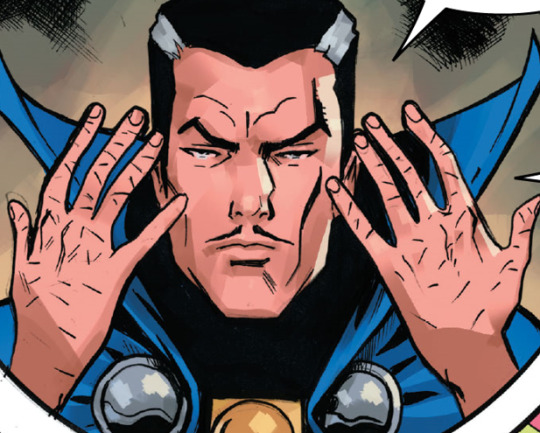
In view of recent ableism and drama on the other social hellsite involving Doctor Strange's disability, here's my response, based on *CANON* material. (link to the thread on said hellsite here)
Stephen disability is established since 1963, back in Strange Tales #115. The story is focused on a flashback which portrays his journey from the decay of his medical career because of a car accident to his path towards the mystic arts.
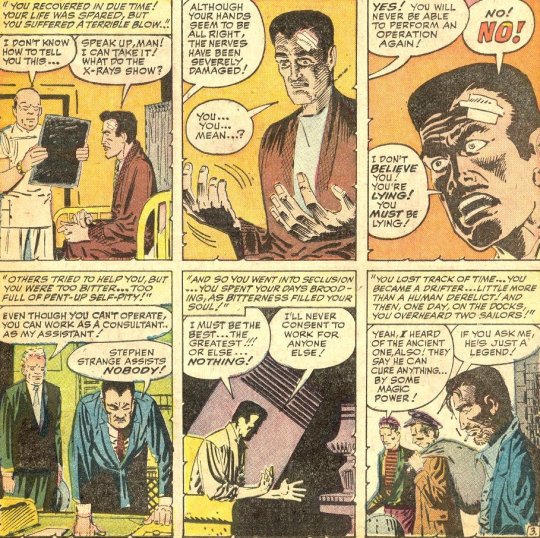
Note that, in this very same issue, the Ancient One never says he would heal Stephen's *hands*, but perhaps Stephen would find the cure within. In other words, Stephen was supposed to heal his heart and soul from arrogance and egoism through magic, not a physical cure.

Also note that there are limitations within every aspect of comic books' universes. In this case, we're talking about magic. Magic is not a miracle thing. It demands training and, most recently as established by v4, a cost (Doctor Strange v4 #4).

Another clue that "magic can heal anything because it's fantasy" is not a valid argument within Marvel's magic world, as seen in The Oath. Stephen had access to the Otkid's Elixir, which could heal any disease, but the formula was lost in order to save Wong's life.

One last example comes from Spider-Man Family #5 (2007), featuring Morbius and Spidey. It establishes that healing demands the exact same price when it comes to magic.

Long story short, it's clear that the magic side of Marvel does not offer a solution to diseases through magical miracles. So this argument is totally invalid ~within~ this established universe.
Now back to Doctor Strange... No, he isn't using magic to heal his hands unlike some misleading accounts are claiming. In fact, there are several panels which show that he's actually in constant pain. Here's some examples:
- Doctor Strange - Sorcerer Supreme #48 (1992).
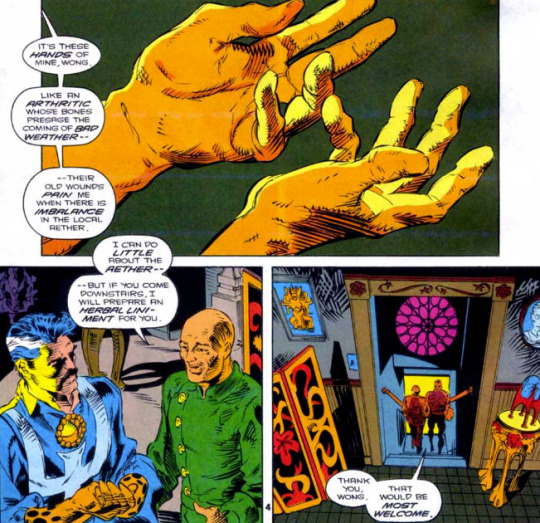
- Captain Marvel v10 #6 (2019)
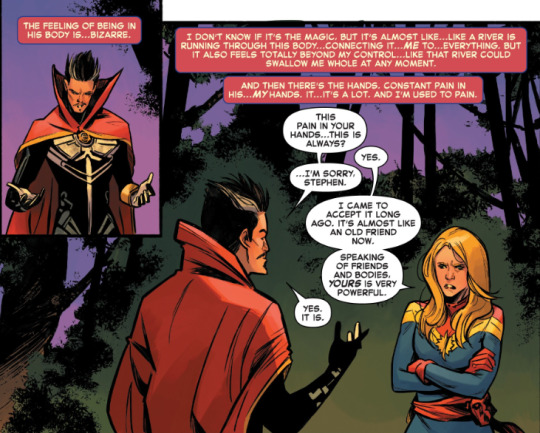
- Doctor Strange v4 #1 (2015)
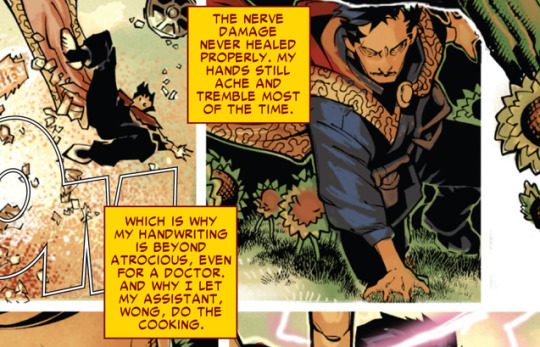
He also struggles to hold a pen and write, relying on magic to do so, as seen in the Book of the Vishanti.

Then comes the stupid argument I saw.
"Oh, but Google says his hands are healed!" is not a gotcha moment you think it is. We had FOUR MAIN BOOKS after that (Surgeon Supreme, DODS, Strange v3 and current v6). Allow me to clarify the details in chronological order.

Stephen indeed made a "magic" gamble and healed his hands. That much is correct. But it's not all (panels from Doctor Strange v5 #19 - 2019).
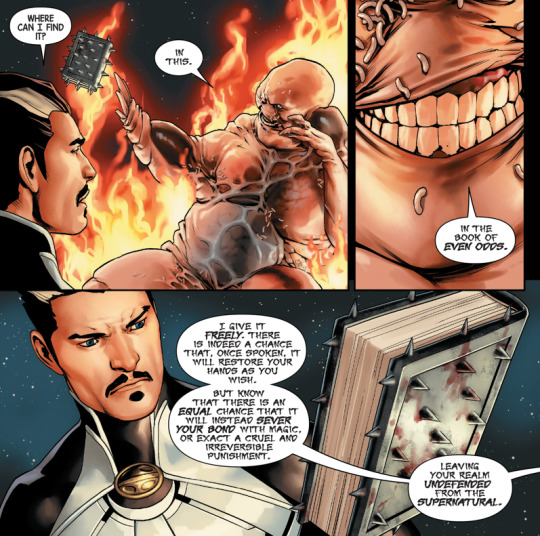

Waid continued this storyline in a new book called Dr. Strange (Surgeon Supreme), which would portray Stephen's duality as the Sorcerer Supreme and a brilliant surgeon. Except the book was cancelled at issue #6 (2020), leaving the character in a kind of limbo. Now enter MacKay.

MacKay kept a little bit of the former storyline as seen in Death of the Doctor Strange #1 (2021). On top of that, his hands appeared healed. However, that lasted only until Kaecilius murdered Stephen and stole his hands.
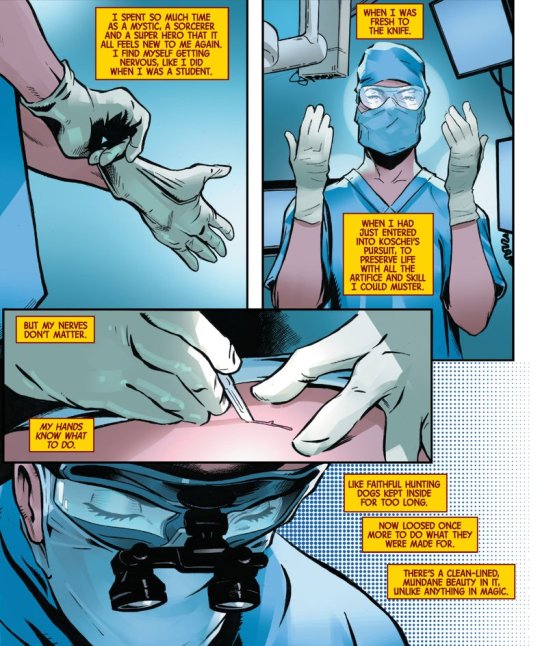
Stephen's temporal duplicate used a regenerative spell to bring original Stephen back through Kaecilius' body and the stolen hands. In here, we can see that his hands are scarred just like after the car accident (DODS #5 - 2022). OG Stephen died a second time with scars as well.


Stephen is indeed seen writing in v6 but it's not clear if he's using magic or not. Besides, he's not working as a surgeon anymore. Moreover, MacKay considers Stephen disabled as seen in this recent issue of v6 (#7 - 2023): "My own connection to the aether, the magic of the world, the power of the Vishanti, the power of the Sorcerer Supreme... Gone. Without all of that? I am just an old man with useless hands and a blade in his stomach."
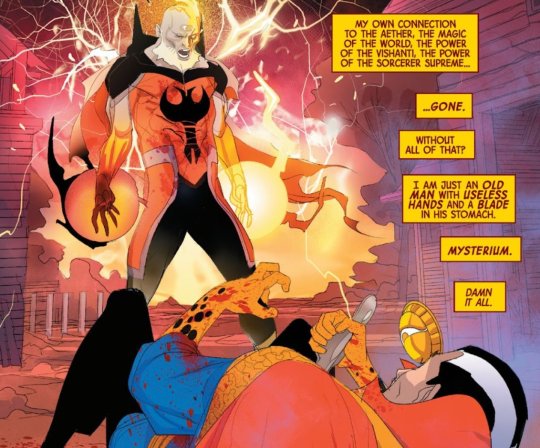
In conclusion,
As of CURRENT DOCTOR STRANGE RUN by Jed MacKay and Pasqual Ferry, in the year of our lord Vishanti, 2024, Stephen Strange is a disabled character and no magic or ableism will erase that. Thank you very much.
206 notes
·
View notes
Text
This is why I hate it when MRAs whine about the courts “favoring” the mothers
How the 'junk science' of parental alienation infiltrated American family courts and allowed accused child abusers to win custody of their kids.
This story was reported in partnership with the nonprofit newsroom Type Investigations.
In the summer of 2020, when he was 12, the boy told his therapist something he'd never told anyone else.
For years, Robert claimed, his stepdad had sexually abused him.
The therapist alerted the San Diego County child welfare agency, which launched an investigation. The county sheriff opened an inquiry, too. Thomas Winenger, the only father figure Robert had ever known, began assaulting him when he was only 7, Robert told a forensic social worker in October 2020. Winenger would pin him down, cover his mouth, and force him into acts he found "disgusting," he said. Sometimes, he said, Winenger recited Bible verses during the attacks, claiming the devil was in Robert's heart.
Robert, whom Insider is identifying by only his middle name, said that as he struggled to breathe, he fought back by hitting, punching, and kneeing his stepfather. But he said Winenger overpowered him.
By the time Robert came forward, Winenger had been named his legal father and was divorced from Robert's mother, Jill Montes, with whom he also shared two young daughters. Robert confronted Winenger with the allegations that November, and within weeks Winenger denied the claims in family court. "This NEVER HAPPENED," he asserted in a filing.
He offered an alternative explanation for Robert's disturbing claims, one that shifted the blame to Robert's mother.
Montes, Winenger contended, had engaged in a pattern of manipulation known as "parental alienation." Robert's accusations weren't evidence that he'd abused the boy, Winenger claimed. They were evidence that Montes had poisoned the children against him. The delayed timing of Robert's allegations, Winenger argued, only made them more suspicious. Montes was causing the children such grave psychological harm, he claimed in the filing, that the children should be transferred to his custody right away.
That December, Child Welfare Services substantiated Robert's allegations, calling them "credible, clear, and concise." But the family-court judge, Commissioner Patti Ratekin, withheld judgment until the following October, when the psychologist she'd appointed as a custody evaluator submitted his own report.
That report, which has been sealed by the court, appears to have convinced Ratekin that Winenger was correct.
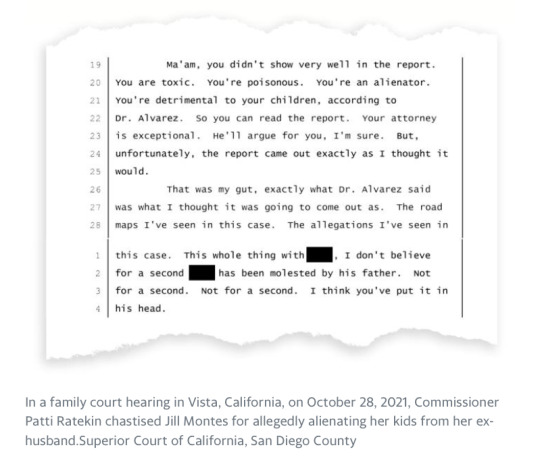
“Ma'am, you didn't show very well in the report. You are toxic. You're poisonous. You're an alienator," Ratekin told Montes at a hearing on October 28, 2021. "I don't believe for a second" that Robert's father molested him. "Not for a second," she repeated. "I think you've put it in his head."
Ratekin acted swiftly, granting Winenger's bid for custody and ordering him to enroll Robert and his sisters in Family Bridges, a program that claims to help "alienated" children reconnect with a parent they've rejected. She barred Montes, a stay-at-home mom and home schooler, from all contact with her children for at least 90 days, a standard prerequisite for admission to the program.
"I just wanted to crumble," Montes said.
Rejected as a psychiatric disorder
Parental alienation is a fairly recent idea, conceived in the 1980s by a psychiatrist, Dr. Richard Gardner, who argued that divorcing mothers, desperate to win custody suits, were brainwashing children against their fathers. In "severe" cases, Gardner wrote, children with "parental alienation syndrome" must be removed from their mothers, transferred to the care of their fathers, and reeducated through what he called "threat therapy."
Alienation has never been accepted as a psychiatric disorder by the medical establishment. Yet today, mental-health practitioners across the United States assess and treat it, particularly those who specialize in custody cases. Many of them collaborate closely, attending the same conferences, following the same protocols, and citing the same papers. Some run reunification programs like Family Bridges; others offer family therapy or produce custody evaluations for family courts.
Influenced by these experts, many judges have given the unproven concept the force of law.
Though most custody cases settle out of court, in a small fraction parents don't come to terms. In some of these contested cases, one parent accuses the other of alienating the children. The most intense disputes arise in cases where one parent alleges spousal or child abuse and the other responds with a claim of alienation.
But alienation claims are highly gendered. Men level the accusation against women nearly six times as often as women level it against men, one study suggests. That landmark study, published in 2020, found that in cases when mothers alleged abuse and fathers responded by claiming alienation, the mothers stood a startlingly high chance of losing custody.
Occasionally, parents accused of alienation are cut off from their children altogether. Since 2000, judges have sent at least 600 children to reunification programs that recommend the temporary exile of the trusted parent, a collaborative investigation by Insider and Type Investigations revealed. While the programs suggest a "no-contact period" of 90 days, this term is routinely extended and may last years, according to an analysis of tens of thousands of pages of court papers and program records.
The treatment typically starts with a four-day workshop for children and the parent they've rejected; aftercare can add months or years. Children may be seized for the workshop by force, with no opportunity for goodbyes.
Former participants at Family Bridges and a similar program, Turning Points for Families, said they were taught that their memories were unreliable, the parent they preferred was harmful, and the parent they'd rejected was loving and safe. In some cases, participants who resisted these lessons said they were verbally threatened; at Family Bridges, a few were threatened with institutionalization. Some participants said they ended up depressed and suicidal.
Program officials say they are helping children. Lynn Steinberg, a therapist who runs a program called One Family at a Time, said in an interview that virtually all the kids she's enrolled have falsely accused a parent of abuse and that she does not accept children into her program whose abuse claims have been substantiated. Without treatment, she said, alienated children would risk being plagued by guilt, and the relationship they wrongly spurned might never heal.
In Steinberg's view, the only child abusers in the families she sees are the "alienators," who have "annihilated" a devoted parent from their children's lives.
Recently, alienation theory has faced rising criticism. Efforts to legitimize the diagnosis have been rebuffed by the American Psychiatric Association, the World Health Organization, and the American Professional Society on the Abuse of Children. And the reunification programs burst into public view last fall, when a video documented two terrified children in Santa Cruz, California, being seized for One Family at a Time. In the clip, which went viral on TikTok, a 15-year-old girl named Maya pleads and shrieks as she's picked up by the arms and legs and forced into a black SUV.
Since then, bills that would restrict reunification programs have been introduced in Sacramento and four other state capitols.
An idea takes off
When a law professor named Joan Meier founded a nonprofit to help victims of domestic violence two decades ago, she didn't expect to focus on custody disputes. But day after day, she heard from mothers with similar, troubling stories. They'd finally escaped their abusive marriages, but their exes had fought them for custody — and won. The mothers had been accused of something Meier knew little about: parental alienation.
Meier, who taught at George Washington University, ordered a stack of books by the child psychiatrist who coined the term.
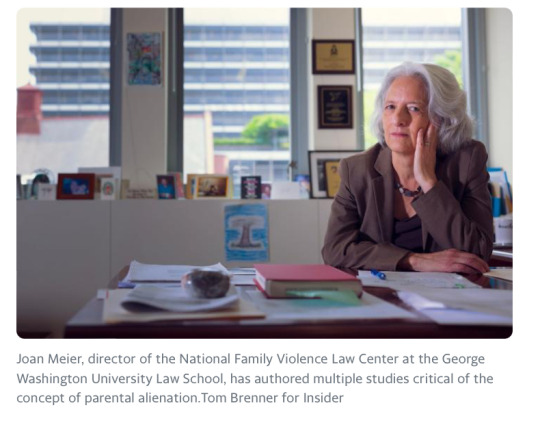
Richard Gardner began writing about children of divorce in the 1970s, when a dramatic transformation was underway in family court. Under the "tender years presumption," judges had long favored women in divorce cases, typically assigning children to their mother's sole custody. But as more women entered the workforce, more men participated in child-rearing, and more couples divorced, a nascent "fathers' rights" movement emerged, demanding gender neutrality in custody proceedings. The idea appealed to many feminists, too. By the 1980s, most states had recognized joint custody in their statutes.
This left judges in a quandary when couples failed to settle. Now, aside from a vague mandate to advance the "best interest" of children, courts lacked a clear paradigm for resolving disputes. Overwhelmed, judges turned to mental-health professionals, asking them to assess each parent's fitness and recommend an optimal arrangement. Gardner, then an associate clinical professor of child psychiatry at Columbia University, was an early custody evaluator, and in 1982 he published a how-to manual.
By 1985, Gardner was arguing that some mothers, seeking to regain their advantage in court, were inducing a mental illness in their children, a condition he dubbed parental alienation syndrome. Children afflicted with the syndrome, he said, could be identified by the "campaign of denigration" they waged against their fathers, which was accompanied by "weak, frivolous, or absurd" rationalizations and a disquieting "lack of ambivalence."
Some "fanatic" mothers even manipulated children into claiming their fathers had sexually abused them, Gardner contended. When other maneuvers against a father fail, he wrote, "the sex-abuse accusation emerges as a final attempt to remove him entirely from the children's lives." Child sexual-abuse claims made during custody disputes, he claimed, "have a high likelihood of being false." To prove children are suggestible, he often invoked the wave of 1980s cases in which preschool teachers were charged with sexual abuse but later exonerated.
Gardner's theory sidestepped what Joan Meier saw as a glaring truth: Many children accused their fathers of abuse because their fathers were actually abusive. In fact, by the early 2000s a large-scale study had found that contrary to Gardner's writings, neither children nor mothers were likely to fabricate claims during custody disputes.
The remedies Gardner proposed for parental alienation syndrome were harsh. "Insight, tenderness, sympathy, empathy have no place in the treatment of PAS," he said in a 1998 address. "Here you need a therapist who is hard-nosed, who is comfortable with authoritarian, dictatorial procedures."
In a 2001 documentary, Gardner told a journalist how a mother might respond to a child reporting sexual abuse: "I don't believe you. I'm going to beat you for saying it. Don't you ever talk that way again about your father."
Juvenile detention could cure children who refused to visit their fathers, Gardner said. But the main remedy he advanced in severe cases was "the removal of the children from the mother's home and placement in the home of the father, the allegedly-hated parent." This would break what he called a "sick psychological bond."
After introducing his theory, Gardner began using it in expert testimony and promoting it to other evaluators and fathers'-rights activists. By the early 2000s, family-court judges were regularly citing parental alienation.
To address this, Meier said, she undertook a series of academic articles examining the scholarship on parental alienation. She found that the theory was based on circular reasoning and anchored almost entirely in anecdotal data.
"I still believed in that day that if you did careful, thoughtful analytic scholarship, people would read it and be persuaded by it," she said.
The scarlet 'A'
Jill Montes had always wanted a big family. In 2008, she already had a 5-year-old daughter, Paige, with a man she'd divorced, and she was finding regular work as an actor in Los Angeles. She decided to adopt an infant son, Robert.
The next year, she met Thomas Winenger, who had master's degrees in engineering and business, on eHarmony. "He wanted to talk a lot about faith and God, and that wooed me," she said. She also welcomed his interest in Robert, whom she was insecure about raising alone.

In 2011, the couple married and settled near San Diego, and Montes quit acting. Soon, she later said in a court filing, Winenger was shoving, insulting, and threatening her, often in front of the kids. He promised to change, and she hoped he could. In 2012, their first child, Claire, was born, and Eden followed in 2015. Insider is identifying Montes' children by only their middle names.
Later that year, Montes accused Winenger of dragging Paige across a room. Montes sought a restraining order, which was ultimately denied, and kicked him out. He rented a room in a house nearby, where he regularly hosted the three younger kids. Sometimes, Robert went there by himself.
Montes filed for divorce in February 2018. Under an informal agreement, the kids continued spending time at Winenger's place. But at a hearing that fall, a 10-year-old Robert testified that during an argument over his math homework, Winenger had repeatedly grabbed, shoved, and spanked him.
Montes filed a petition for a domestic-violence restraining order, which Winenger fought, saying he hadn't mistreated Robert. In the end, Ratekin, the judge presiding over the divorce, signed a "stay away" order prohibiting Winenger from contact with Robert. But it didn't address the allegation of violence. Weeks later, Winenger asked Ratekin to name him Robert's legal father, arguing that he'd helped raise the boy from toddlerhood. Ratekin ruled in his favor and ordered the custody evaluation.
In court papers he filed on July 19, 2019, the day after the evaluator was appointed, Winenger accused Montes of parental alienation.
Often, according to Meier, the dynamic of a custody case shifts radically once alienation is raised. "It's like the table turns 180 degrees and now the only bad parent in the room is the alleged alienator," she said. An abuse allegation "fades out of view," she said, and any attempts by the mother to limit the father's access are seen as suspicious. It's almost as if, like Hester Prynne in "The Scarlet Letter," she's been branded with a flaming red "A," Meier said.
Indeed, Montes soon lost ground in court.
In January 2020, Ratekin ordered Robert into the care of a therapist, Mitra Sarkhosh, who has since provided aftercare for at least one reunification program. Sarkhosh saw Robert and his father together about 20 times, charging $200 an hour. But by summer, she had halted the sessions, saying Robert's anger was "not improving."
In a report filed in court, Sarkhosh appeared to blame Montes. Living with her, Robert was "saturated with negativity about his father," she wrote. There may be a need for "new interventions." (Citing patient-confidentiality laws, Sarkhosh declined an interview request.)
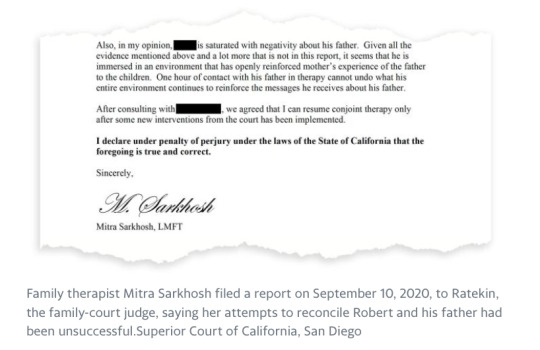
Robert was relieved to be finished with Sarkhosh, Montes said. He started seeing a new therapist, and, during the first session, he told the therapist he'd been sexually abused.
On November 18, 2020, at the direction of the San Diego County Sheriff's Department, Robert called Winenger to try to elicit a confession. When that failed, the department paused its investigation, but the child welfare inquiry proceeded. On December 1, the California Health and Welfare Agency issued a report substantiating Robert's claims.
"The Agency is worried that if given the opportunity, Tom Winenger will sexually abuse [Robert] again," the report says.
Neither Winenger nor his divorce attorney, Tamatha Clemens, responded to requests for interviews or to a list of detailed questions. In a motion for custody he filed on December 8, 2020, Winenger argued that Robert's allegations had been "orchestrated" by Montes and that her alienation "will not stop until she is restrained by the court."
The welfare agency sent Ratekin its report on January 4, 2021, according to a cover sheet reviewed by Insider. But Ratekin was still awaiting the custody evaluation, which she'd assigned to a psychologist, Miguel Alvarez. In 2009, Alvarez coauthored a handbook for parents in custody disputes. While the manual spells out in detail how to prove an alienation claim, it offers no specific guidance on how to prove a claim of abuse.
According to the report, part of which Insider reviewed at a San Diego County courthouse, a personality test Alvarez administered suggested that Montes suffered from "extreme hyper-vigilance" and "persecutory fears." People with these traits, Alvarez wrote, "are often quick to anger and overreact to perceived or imagined threats."
Winenger's scores on the same test were "normal," Alvarez wrote, and his performance on psychosexual and polygraph tests was "inconsistent" with Robert's allegations of sexual abuse.
The 136-page evaluation cost Robert's parents more than $90,000, according to bills reviewed by Insider. Alvarez didn't respond to requests for comment.
Ratekin reviewed the evaluation just before the October 28, 2021 hearing. Alvarez's findings were "exactly" what she'd expected, she said. In her view, the situation called for immediate action.
She put Claire, 8, and Eden, 6, in their father's custody that day, and she sent Robert, 13, to stay with his football coach. That was for Winenger's protection, she said. Until Robert was "detoxified," she said, he'd be prone to false claims of abuse.
Ratekin suggested Family Bridges as a solution. She'd had "really good success" with the program in another case, she said, and she thought it would ease Robert's transition. Without it, the boy wouldn't "get better," she said, and his sisters stood to benefit, too.
Winenger agreed. Under an order Ratekin signed on January 3, 2022, the children would attend a Family Bridges workshop with their father from January 11 to 14 and then return to his home. Montes was barred from contact with the children for at least 90 more days. Ratekin also prohibited the children from communicating with their older sister, their maternal grandmother, and anyone else who might "interfere" with their healing.
Contact would resume at Ratekin's discretion, depending upon how well everyone was cooperating.
Insider and Type reviewed 35 cases from the past two decades in which judges removed children from their preferred parent and sent them to a reunification program. In most of these cases, the children had resisted court-ordered visits with their fathers, and judges had held mothers responsible. Many of the judges framed the no-contact period as salutary: Children would be freed from the overbearing influence of their mothers, and their mothers would be motivated to change.
A case from New Castle County, Delaware is typical.
In 2016, Judge Janell Ostroski transferred two brothers to their father's custody and ordered them into treatment at Turning Points for Families, a program in upstate New York run by a social worker, Linda Gottlieb. Both boys had told Ostroski that their father, Michael D., yelled at them frequently, court records show, though neither had alleged physical abuse. The 9-year-old, O., told Ostroski he felt unsafe at his dad's house. Ashton, 14, was refusing to go there. Insider is not using the family's full last name in order to protect O.'s identity.

Michael had pleaded guilty several years earlier to public intoxication and indecent exposure for an incident in a public park with Ashton. A court-ordered psychological evaluation found that he had alcohol dependence and narcissistic personality disorder "with antisocial features." In 2013, the state's child welfare agency found that he'd emotionally abused Ashton, then 10 years old. The report, including any denials Michael presented, is sealed. This history was all cited in court three years later, in a custody dispute between Michael and his ex-wife, Kelly D.
During that dispute, Michael accused Kelly of alienation, and a custody evaluator backed him up. The evaluator, a psychologist, determined that Michael had become "a more positively functional person" and that Kelly, a preschool teacher, was the problematic parent. Kelly "distorts the reality of events" and "conveys to others an inaccurate and menacing perception of Mr. [D.]," the psychologist wrote in a May 2016 report. (Michael did not respond to detailed requests for comment. Neither did the psychologist.)
In written rulings that barred Kelly from contact with both children, Ostroski said the boys were "well cared for" in Kelly's home but blamed her for Ashton's refusal to see Michael. "Mother has done nothing in the past year to promote the Father/son relationship," Ostroski wrote, adding, "the court is hopeful that, with the appropriate interventions, Mother can recognize her role in helping the children have a healthy relationship with their Father."
Insider and Type sent questions about parental alienation and its remedies to Ostroski, Ratekin, and 19 other judges who've ordered the programs. Only Ratekin responded, and she declined to speak about the Winenger case because it is still pending. Nor would she answer general questions. "I am definitely not an expert in this area," she wrote, "nor do I feel qualified to answer questions about the issue or programs."
'A moratorium on the past'
In her January 2022 ruling, Ratekin authorized Winenger to hire a transport company to drive Robert and his sisters to the Family Bridges workshop, which would take place at a hotel a few hours outside San Diego. There, the children and Winenger met Randy Rand, who founded Family Bridges in the early 2000s, and a woman the children knew only as "Chris."
In 2009, Rand deactivated his psychology license after the California Board of Psychology found he'd committed professional violations including "dishonesty," "repeated negligent acts," and "gross negligence." Since then, he's accompanied at workshops by at least one other clinician.
Rand isn't the only alienation expert to face sanctions from a state licensing board. Two other psychologists who've led Family Bridges workshops, Jane Shatz of California and Joann Murphey of Texas, have been sanctioned — Shatz after an allegation of negligence and Murphey after a finding that she failed to respond promptly to a subpoena. Both Alvarez, the custody evaluator in Robert's case, and Steinberg, who runs the program where a judge sent the girl in the viral TikTok, have been cited by California regulators for improper recordkeeping. Steinberg said her citation was the result of a series of meritless complaints by an "alienating parent."
Family Bridges workshops are held at hotels around the country and tend to cost parents more than $25,000, receipts show. In 2016, for example, one family from Seattle paid more than $27,000 to Family Bridges and another $3,500 to spend three nights at a Sheraton in Southern California. Since the children had opposed the intervention, a company was hired to transport them for an additional $8,300.
Once they arrive at Family Bridges, children quickly learn the rules, program documents show, including a policy called "a moratorium on the past." As Murphey, the Texas psychologist, testified in 2018, "There's no talking about 'You did this back when.'" Instead, she explained, "this is a new family, this is a new paradigm, we are starting off in a healthy way."

Ally Toyos was a 16-year-old in Kansas when she was taken from her mother five years ago. In an interview, she said she and her then 14-year-old sister tried defying the Family Bridges moratorium, telling Rand and his colleagues that their dad had abused them. (Toyos' mother said a court order prevented her from speaking with the press; Toyos' father didn't reply to interview requests.) Threats ensued, Toyos said. The girls were told that if they didn't comply, they could be separated, sent to wilderness camps, committed to psychiatric facilities, and cut off from their mom for the rest of their childhoods, according to Toyos.
Much of the Family Bridges workshop involves watching and discussing videos, program documents show. One of them, "Welcome Back, Pluto," tells the fictional story of a petulant teen who scorns her father. "If you're alienated, like Emily, you might get mad when others don't take your complaints seriously," a female narrator says. In time, however, Emily "learned to see things more clearly." She realized her complaints were "exaggerated," the narrator explains, and "sounded just like her mother's."
According to the video, which was scripted by Richard Warshak, a psychologist who helped develop Family Bridges, some children who steadfastly reject a parent "suffer for the rest of their lives."
Other materials warn children against trusting their memories. Toyos, whose workshop took place at the C'mon Inn in Bozeman, Montana, said she was shown a 2013 TED Talk by Elizabeth Loftus, a psychologist who developed the idea that memory is malleable and who has served as a defense witness in high-profile trials, including Harvey Weinstein's. Memories are often contaminated by outside influences, Loftus warns in the talk, which leads to false accusations that can ruin lives.
Insider and Type spoke with or reviewed statements by 17 youths ordered into Family Bridges, Turning Points, or other reunification programs. Their accounts of the workshops were broadly similar. Hannah Rodriguez, then a 16-year-old living in Tampa, Florida, said her workshop, in 2016, was held at Linda Gottlieb's home in New York's Hudson Valley. Gottlieb, the author of a book on parental alienation syndrome, had founded Turning Points about two years earlier. Rodriguez said Gottlieb's office was right off the living room, where her husband spent his time in a recliner. Every day, Rodriguez could see him and hear his TV shows, she said.
Rodriguez, Toyos, and several other former participants said the workshops plunged them into depression.
In spring 2022, one 13-year-old girl got so distressed during a session with Gottlieb at a hotel that she banged on a wall and screamed for help, court papers show. Someone called the police, who brought her to a hospital for a psychiatric evaluation. "I just want my mom," the girl said, according to hospital records, but under the court order she couldn't call her. She was held at the hospital for three days.
In a written statement that Montes said he later dictated to her, Robert said he became suicidal. "The only thing that stopped me from throwing myself off the balcony was the 24/7 surveillance," the statement reads. "I never thought so many people would be that horrible, controlling, and manipulative towards little kids."
At the end of the workshop, Robert went home with Winenger and had "horrible, weird depressive anxiety episodes," according to the statement. In early February, he was admitted to the psychiatric ward of a children's hospital, according to court records.
Repeated emails to Rand were met with an auto-response saying he was "on sabbatical." The psychologist managing Family Bridges in his absence, Yvonne Parnell, declined interview requests, as did Gottlieb. Gottlieb forwarded Insider's queries to a lawyer, Brian Ludmer, but Ludmer said he couldn't speak for her. Neither Parnell nor Gottlieb replied to detailed written questions.
Lynn Steinberg said her program One Family at a Time, based in Los Angeles, has treated some 50 families over the past eight years. A family therapist, she's the author of "You're Not Crazy: Overcoming Parent/Child Alienation." She was the only program director who agreed to talk.
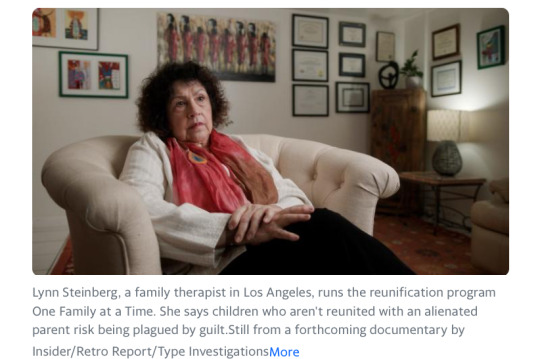
She said she begins each workshop by listening to the children and taking down every accusation they make; she then works to achieve "an agreement between parent and child." After those conversations, she said, the children are dramatically transformed. They apologize and cry, she said; they kiss and embrace the parent they'd rejected, even sitting in the parent's lap. They're eager to make up for lost time, she said, and can't wait to see long-lost kin.
Daniel Barrozo, of Chino, California, said Steinberg's workshop was a "tremendous help" to him and his daughter in 2021. Steinberg successfully challenged his daughter's misperceptions about him, he said. When Steinberg asked her what he'd done wrong and what she hated about him, his daughter simply looked down and cried, he said. "The whole time, she had nothing to say, because Mom was the one speaking for her," he said. Now, he said, his relationship with his daughter is stronger than ever.
Steinberg said her own mother alienated her from her father, a realization she reached only after his death. She called her ex-husband an alienator, too, saying her adult daughters reject her to this day. She regrets that they didn't get help from a program like hers.
Left untreated, alienated children "fail at relationships" and risk developing eating disorders, drug addiction, depression, gender dysphoria, and other ills, Steinberg said, citing her clinical experience.
But an increasing number of scholars are criticizing the programs. Jean Mercer, an emeritus professor of psychology at Stockton University, is the author of recent papers on parental alienation. One examined six reunification programs, including Family Bridges and Turning Points, and found that the research evidence supporting the effectiveness of the programs "has few strengths and many weaknesses." For another paper, Mercer reviewed the scholarship on the programs and statements from five youths who'd attended them. She found that the programs "may contain elements of psychological abuse."
Another study, by Michael Saini of the University of Toronto, examined 58 empirical papers on alienation and its treatments and found the body of research "methodologically weak." While some divorcing parents exhibited "alienating behaviors" and some children rejected a parent, the nexus between those phenomena hadn't been proved, Saini found. Moreover, he found the studies hadn't shown that interventions worked.
Following the workshop, the programs commonly assign children to a specially trained aftercare therapist. Meanwhile, the exiled parent undergoes reeducation.
Insider obtained audio of a call last year between Gottlieb and the mother of a 14-year-old girl and a 12-year-old boy in Turning Points. "I think what you did is criminal," says Gottlieb, who, like Steinberg, has publicly stated that her own mother alienated her from her father. There was "no reason" the children shouldn't have a relationship with their father, Gottlieb says in the recording, and "you have failed miserably to require it."
"That's alienation," she says. "That is what you are guilty of, and it's child abuse." For the children's sake, the woman must "make amends," Gottlieb says. Otherwise, "I will recommend extending the no-contact period until they're 18."

Insider and Type interviewed 12 mothers whose children were sent to Turning Points, many of whom said Gottlieb rebuked them over the phone and in emails. Most said they were required to write letters to the kids praising their fathers and submit them to Gottlieb for approval.
In early November 2016, Gottlieb told Kelly D. — Ashton and O.'s mother — that her letters contained superfluous details and secret messages and needed to be redone. In the end, Kelly submitted several drafts for each of her sons, all of which Gottlieb rejected.
"She sets a bar," Kelly said. "You try to reach the bar. She sets the bar higher."
Judge Ostroski had ordered Kelly to find a therapist "acceptable to Ms. Gottlieb" who would help her support Michael's relationship with the children. From a list provided by the Delaware Family Court, Kelly chose a psychologist, William Northey. But Gottlieb warned in an email, "I cannot approve him before I speak with him about his specialized knowledge of alienation."
The conversation went poorly. Gottlieb considered Northey unacceptable, she later testified, and Northey found fault with Gottlieb, too. He sent her a letter, reviewed by Insider, criticizing her for calling Kelly a "sociopath" and for using the phrase "parental alienation syndrome," which, he wrote, "is not a recognized diagnostic term."
Meanwhile, Gottlieb was making demands of Ashton and O. Shortly after they returned from New York, according to an email to both parents obtained by Insider, Gottlieb determined that they needed to transfer schools immediately, as their current schools had "actively undermined" their relationship with their dad.
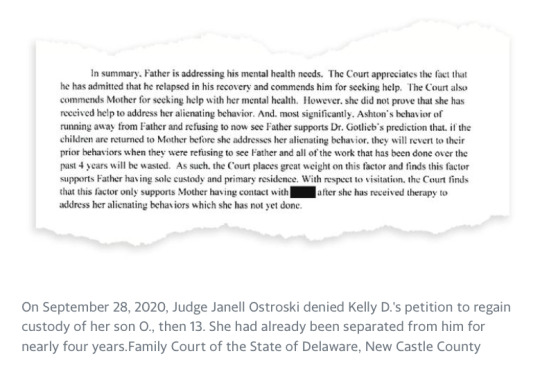
She sought custody of O., too. But in September 2020, Ostroski found that Kelly still hadn't been properly treated for her alienating tendencies and denied her petition.
For now, even visits were too risky, Ostroski concluded.
"Ashton's behavior of running away from Father and refusing to now see Father supports Gottlieb's prediction that, if the children are returned to Mother before she addresses her alienating behavior, they will revert to their prior behaviors when they were refusing to see Father and all of the work that has been done over the past 4 years will be wasted," Ostroski wrote in the ruling.
'Junk science'
In June 2010, more than a thousand mental-health practitioners, lawyers, and judges gathered at the Sheraton in downtown Denver for the annual conference of the Association of Family and Conciliation Courts, which unites players in the child-custody field from around the world. The theme that year was "Traversing the Trail of Alienation," and over four days the condition was discussed in more than 30 sessions. Participants could learn how to spot an alienating parent, when it was best to defy a child's wishes, and what might help an alienated child heal.
The event signified a remarkable embrace of an idea whose author had been consumed by scandal and tragedy just a short time earlier.
In the late 1990s, critics of Gardner's dealt a powerful blow to his credibility by unearthing writings in which he'd defended pedophilia.
"Sexual activities between an adult and a child are an ancient tradition," he wrote in a 1992 book.
As a product of Western culture, he viewed pedophilia as reprehensible, he wrote, but it may not be "psychologically detrimental" in other cultures. The following year, in a journal article, Gardner argued that from an evolutionary standpoint, children benefited from being "drawn into sexual encounters," since these experiences steered them toward early reproduction. "The Draconian punishments meted out to pedophilics go far beyond what I consider to be the gravity of the crime," he wrote in 1991 in "Sex Abuse Hysteria: Salem Witch Trials Revisited."
In May 2003, at age 72, Gardner dosed himself with painkillers and stabbed himself to death. His son told reporters he was driven to suicide by chronic pain that had recently worsened.
In the assessments of his life that followed, Gardner's work was lambasted by prominent psychiatrists, including Dr. Paul Fink, a past president of the American Psychiatric Association. "This is junk science," Fink told Newsday in July 2003. "He invented a concept and talked about it as if it were proven science. It's not."
The theory could have died with Gardner. Instead, it gained ground.
In 2001, Richard Warshak, a clinical professor of psychology at the University of Texas Southwestern Medical Center, published "Divorce Poison: Protecting the Parent/Child Bond From a Vindictive Ex." The book, released by HarperCollins, brought parental alienation theory to a wider audience — and made it more palatable. Unlike Gardner, Warshak spoke of alienation in gender-neutral terms, saying many fathers were programmers, too, and he likened the no-contact period between children and their preferred parent to study abroad.
Warshak started leading workshops for Family Bridges around 2005 and eventually became its unofficial spokesman, a role in which he excelled. In 2010, he appeared in "Welcome Back, Pluto" and published an influential article about Family Bridges in the AFCC journal.
In that study, Warshak reported on outcomes for the 23 children he'd worked with in the program so far. During the four-day workshop, 22 of them recovered a "positive relationship" with their rejected parent, he observed, including recalcitrant teens.
After the workshop, however, four children regressed, Warshak wrote, following what he called "premature" contact with their preferred parent. The program worked best, he said, when this contact was blocked "for an extended period of time." Warshak didn't respond to interview requests.
Meanwhile, another Gardner successor, Dr. William Bernet, a professor of psychiatry at Vanderbilt University, was working to push alienation theory forward. He submitted a proposal to the American Psychiatric Association to include "parental alienation disorder" in the next version of its Diagnostic and Statistical Manual of Mental Disorders, or DSM, and authored a scholarly article making the case for inclusion. He submitted a similar application to the World Health Organization, which was revising its International Classification of Diseases.
Bernet declined a request for an interview. But in a 2010 book, he wrote that since alienation scholarship had advanced in the wake of Gardner's death, "there is no need now to dwell on the details of what Richard Gardner did or said or wrote."
At the AFCC's conference in Denver in June 2010, Warshak was given a platform to discuss his Family Bridges paper, as was Bernet, to describe his DSM bid. Other presenters staked out a more moderate stance, arguing that while alienation was a pervasive problem, there was insufficient research to support construing it as a mental illness or ordering extreme interventions.
A few alienation opponents presented, including Joan Meier. But she said she flew home to Washington in tears.
"Everywhere I turned, alienation was the coin of the realm," she said.
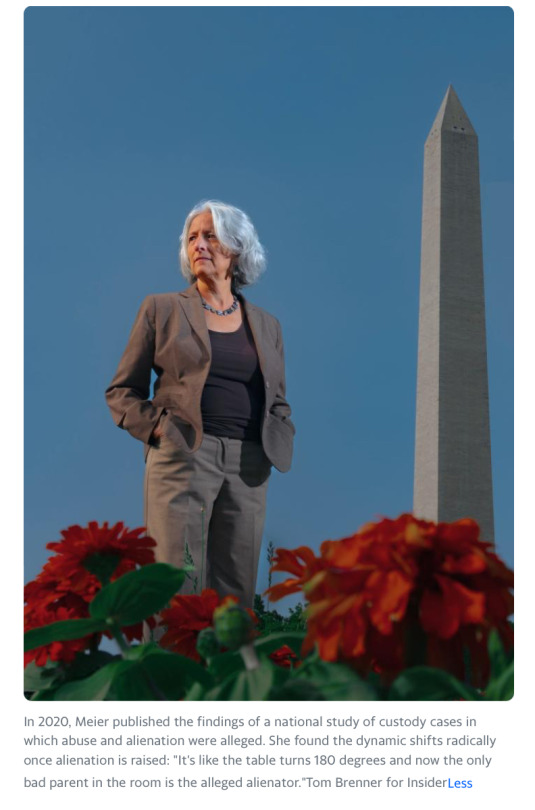
She set out to design a study that would document how women who alleged abuse were treated in family courts nationwide — especially when alienation was raised. The Justice Department supported the project with a grant of $500,000.
In 2013, the new edition of the DSM was released with no mention of parental alienation. And in 2020, the World Health Organization ruled that parental alienation was "not a health care term" and lacked "evidence-based" treatments.
Bernet and his colleagues simply regrouped. In court, they started calling alienation a "dynamic" or a "phenomenon" rather than an illness, which appeared to satisfy some judges. And Bernet incorporated the nonprofit Parental Alienation Study Group, a coalition of parents, lawyers, and therapists who collaborated on cases and research. Rand, Gottlieb, and Steinberg joined, along with hundreds of other mental-health practitioners involved in custody work. Many, like Steinberg and Gottlieb, claimed to have experienced alienation themselves.
Meier assembled her own research team, comprising a statistician, three social scientists, and two assistants, to conduct her large-scale study. In January 2020, just weeks before the WHO decision, the results were published in the Journal of Social Welfare and Family Law.
The stark findings shocked even her.
Most trial-court rulings in custody cases are unpublished, but Meier's team identified 15,000 rulings involving abuse or alienation that were published electronically from 2005 to 2014. After winnowing that dataset to cases in which the only parties were two warring parents — not, for example, a child welfare agency — the team was left with 4,300 rulings. There were nearly 2,200 cases in which a mother had accused her ex of spousal or child abuse, and in 10% of these, the father had fought back with an alienation claim.
In general, judges were hesitant to credit mothers' abuse claims. When alienation wasn't raised, judges credited these claims 41% of the time, Meier found, and 26% of the time, mothers lost primary custody.
For the 222 mothers whose spouses accused them of alienation, the picture was even grimmer. Women who alleged abuse and whose husbands accused them of alienation lost custody half the time — twice as often as women who weren't accused of alienation.
To Meier, one of the study's most staggering findings was how rarely mothers branded with the scarlet "A" were believed. In cases where mothers alleged child physical abuse and fathers cross-claimed alienation, judges credited mothers a mere 18% of the time, she found. And in the 51 cases where mothers alleged child sexual abuse and fathers claimed alienation, all but one mother was disbelieved.
For a father accused of child molestation, Meier concluded, "alienation is a complete trump card."
'The whole world is watching'
In January 2022, three months after losing her children, Montes chanced upon a sickening discovery.
In a cloud storage account she'd once shared with Winenger, she said, she found thousands of his photos and videos, including explicit images of their three shared children. She loaded them onto a thumb drive for the San Diego County Sheriff's Department, whose investigation into Winenger had never closed.
Within days, Winenger was arrested. He was soon charged with 19 felonies, including possession of child pornography and 14 counts of committing forcible lewd acts against a child, Robert.
He pleaded not guilty and was released on bail, his access to the children suspended. Because of the no-contact order he'd previously obtained against Montes, the children landed in a county shelter. Winenger's defense attorney, Patrick Clancy, declined to comment on Winenger's behalf, saying he doesn't try his cases in the press.
Suddenly, the custody dispute was transferred to juvenile dependency court, which meant Ratekin was no longer presiding. The new judge ordered the kids into their mother's care while the case was pending. On February 18, they came home.
At first, Montes said, the two youngest children were so scared of being taken again that they couldn't sleep in their rooms. She set up a big mattress on her bedroom floor.
Meanwhile, Joan Meier was using her research to make inroads with policymakers.
She'd worked with colleagues to draft a federal law that would incentivize states to protect children from abusers during custody disputes. They named the bill Kayden's Law, after a girl in Pennsylvania whose father murdered her during a court-ordered visit. During negotiations over reauthorization of the Violence Against Women Act, the child's congressional representative, Brian Fitzpatrick, got Kayden's Law in.
The legislation, signed into law on March 15, 2022, sets aside up to $5 million a year for grants to states if, among other measures, they mandate training for custody judges on abuse and trauma and prohibit them from ordering treatments that cut children off from a parent to whom they are attached. If enough states comply, the law could spell the end of the reunification programs.
Last summer, California was the first state to consider such a bill. It was introduced by state Sen. Susan Rubio of Los Angeles County, a survivor of domestic violence herself, after she heard from mothers who'd been accused of alienation and children who'd been sent to reunification programs.
Rubio's bill set off a battle that has since spread to statehouses around the country. Steinberg, the alienation therapist from Los Angeles, was a vocal opponent, arguing that men would be rendered powerless against false accusations. She was joined by fathers' rights groups and by the Parental Alienation Study Group, which was simultaneously pushing hard to discredit Meier's study. (Two prominent members of the group authored a studyconcluding that her findings could not be replicated, which Meier then rebutted.) After Rubio's bill passed the assembly unanimously last August, she was forced to withdraw it in the face of intense opposition from state judges over the training mandate.
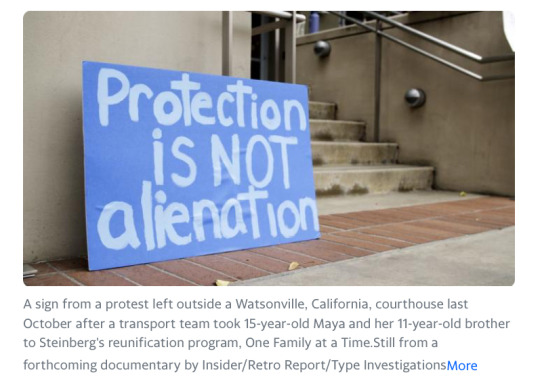
Then, last October, the momentum shifted. That's when Maya, the 15-year-old from Santa Cruz, told a custody judge that her mother had abused her and her brother. The judge, Rebecca Connolly, didn't believe her and ordered the children into Steinberg's program, cutting off contact with their father. The graphic video of the children being seized on October 20 was quickly viewed millions of times.
In response to an interview request, an officer of the Santa Cruz County Superior Court said Connolly could not speak about pending cases. Maya's mother has denied the abuse claims in court. Her lawyer, Heidi Simonson, declined an interview, citing court orders pertaining to "privacy and confidentiality."
On the heels of the viral video, a coalition of activists — many of them mothers accused of alienation — organized protests around the country. The first took place October 28 outside the courthouse where Maya had just testified. Standing on concrete risers and facing the building, a pack of Maya's friends demanded her return. "The whole world is watching!" they shouted. Protests also erupted in Michigan, Kansas, and Utah.
Rubio introduced a new bill, with modified judicial training requirements, in February. A similar bill passed both chambers of the Colorado legislature in April. One in Montana died in committee; its sponsor, Sen. Theresa Manzella, said she was up against a "deliberate distribution of misinformation" by opponents, including attorneys who use parental alienation as a legal tactic.
Montes said she's "cautiously optimistic" about Winenger's criminal trial, set to begin in June, and she hopes for an imminent victory in her custody case. Five years of legal bills have left her in debt and on food stamps, she said, but she considers herself lucky all the same. Almost every day, she talks to mothers who remain severed from their children.
Mothers like Kelly D., whose children were sent to Linda Gottlieb's reunification program in New York.
Kelly last saw her younger son, O., early on a Monday morning. It was a warm, sunny day, and she dropped him off at his best friend's house so they could shoot baskets before school. She hugged him, told him she loved him, and said she'd pick him up in the afternoon. Then she drove to court for a hearing.
That was six years, six months, and 24 days ago.
The reporting for this story is part of a forthcoming documentary from Insider, Retro Report, and Type Investigations.
If you are experiencing domestic abuse, you can call the National Domestic Violence hotline at 1-800-799-7233.
Read the original article on Insider
#USA#family courts#Child custody#abusers making themselves the victims#Parental alienation#Children being abused after the courts removed them from their mothers#Family Bridges#Dr. Richard Gardner#Reeducating children#Threat therapy#Long article#State sponsored gaslighting of children#Lynn Steinberg#One Family At A Time#Pathologizing abuse victims
847 notes
·
View notes
Text
Apocalyptic rhetoric is just as dangerous as the violent kind

Paul Waldman is absolutely correct about how the Republican's "apocalyptic rhetoric" about the Democrats could ultimately lead to violence just as much as the violent rhetoric. The GOP frames Democrats now as deliberately wanting to "destroy" America. (Ironically, it is the GOP who have turned toward autocracy and seem determined on establishing one party rule at all costs. This suggests that once again, Republicans are projecting onto Democrats.)
“I cannot stand these people that are destroying our country,” said Rep. Matt Gaetz (R-Fla.) to a crowd of Donald Trump’s supporters at the Iowa State Fair this past weekend while the former president looked on approvingly. Gaetz then added: “Only through force do we make any change in a corrupt town like Washington, D.C.”
The second part of that statement made headlines, as it’s not every day that a member of Congress advocates “force” to achieve political goals. But the first part ought to be just as troubling, because the two parts operate together. The idea that our opponents are purposely attempting to lay waste to America is often the justification for all kinds of radical action — violence very much included.
Barely a day goes by without prominent Republicans repeating that claim. Trump regularly says his political opponents will “destroy the country,” or have already nearly destroyed it. It’s a staple of Florida Gov. Ron DeSantis’s rhetoric. “If woke ideology takes over, it will destroy this country,” DeSantis says. If President Biden is reelected, the governor insists, “the left is gonna absolutely destroy this country.”
[...]
Yes, liberals have made dire warnings about a second Trump presidency. But that’s unique to Trump, who actually tried to overturn a lawful election and retain power, and last year called for the “termination” of the Constitution. So the assertion that if he became president it could mean the end of democracy is at least not too far-fetched.*
The talk of the United States ending its run some time in the next few years because Democrats passed some modest expansion of health coverage or kept pushing for a transition to green energy, on the other hand, is bonkers. Yet, unlike other kinds of rhetorical calls to extremism, we don’t police it at all.
Journalists tend to be very attuned to hints of political violence. When a candidate says he wants to start “slitting throats” in the federal government, as DeSantis recently did, we condemn it and explore its troubling implications. We press Republican contenders to admit that Biden fairly won the 2020 election and to repudiate the violent insurrection of Jan. 6, 2021.
In contrast, we treat partisan apocalyptic rhetoric as mere hyperbole. But it’s the premise that turns anger into action. If you actually believed your opponents were literally trying to destroy your country, what wouldn’t be justified? Threatening election officials? Storming the Capitol? Assassinations?
You might protest that Republican politicians don’t really believe this talk. But clearly, many of their supporters do. Which is no surprise given how often they’re told that it’s true.
[...]
Any rational Republican knows the truth about the next election: If Biden wins, it will mean nothing more than four years of policies they don’t like. That will be deeply unpleasant for them. But it won’t mean the end of America, and they shouldn’t be allowed to say so without challenge.
We ought to treat apocalyptic rhetoric just like we treat violent rhetoric: Take note of it, condemn it, challenge candidates to defend it, and explain the threat it poses. Why? Because many of the voters who are listening think the Republicans spinning out wild tales of America’s imminent destruction mean what they say.
[emphasis added]
____________
*In my opinion it isn't just Trump, many on the left have legitimate concerns about extreme right-wing Republicans like DeSantis and white Christian nationalists who seem to want autocracy/ one-party rule because they have either said and/or shown that they do.
#republicans#apocalyptic rhetoric#gop lies about democrats can indirectly lead to violence#donald trump#paul waldman#the washington post
458 notes
·
View notes
Note
what are some upcoming xiyouji media that you’re excited for?
Here are a few!

2020 Journey to the West: Conquer the Demons 西游降魔篇 - I think this is like a re-write of the whole Chow Xiyouji films into a tv series!

2020 I'm Not a Great Sage 我不是大圣 - the Six-Earred Macaque being seen as a hero when he is trying so hard to be a villain. (Correction there are two movies with the same name and I got the poster for the wrong one whoops)

2021 Seven Sages 七圣 - a movie all about Wukong's brotherhood like with Snub-Nose Monkey King or Flood Dragon King!

2021 Sun Wukong: Heaven Devourer Monkey孙悟空之噬天魔猴 Trailer - the animation for this looks AMAZING AND I CANT WAIT!!!

2022 King of Confusion: The Rise of the Great Sage / Four Monkeys in Confusion 混世之王:混世四猴 /混世之王之大圣崛起 - Super excited to see Wukong and ALL THE SPIRITUAL MONKEYS!!! FINALLY THE WHOLE GANG IS HERE

2022 Bajie: Movie Preview 八戒:電影搶先看 - I am a huge Bajie fan and this just looks ADORABLE!
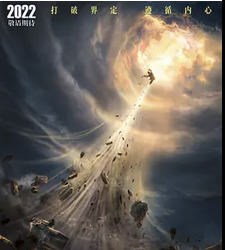
2022 The Lower Boundary of the Canopy of Bajie八戒之天蓬下界 - Another Bajie love story and honestly this one looks precious, he really trying to just get his weapon back but oh no he is being WOOED!

2022 Red Boy: Newborn Calf红孩儿之初生牛犊 - super fun animation! Really want to see the back story in this one!

2022 Monkey King and JJ大圣和江流儿 - I NEED THIS I NEED THIS LIKE WATER I NEED HERO IS BACK WUKONG TO BE A FATHER PLEASE

2023 The Legends of Monkey King 凌云志 - This was based on like a web novel and it sound more insane that it should be. can't say it is "good" but it def sounds interesting at LEAST.
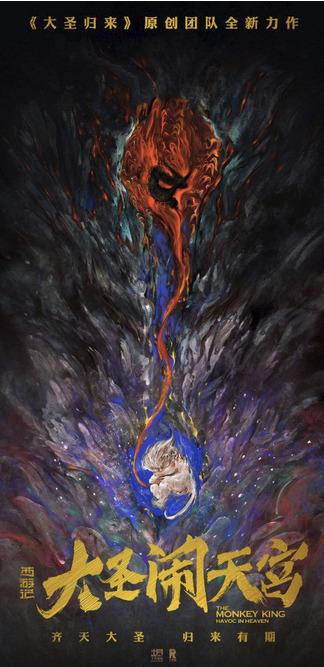
2025Monkey King: The Havoc in Heaven西游记之大圣闹天宫 - I have heard that THIS is going to be a prequel to the 2015 Hero is Back Movie SO !!!!!!!!!!!! WOULD LOVE TO SEE MORE HERO IS BACK WUKONG HE IS LIKE MY SECOND FAVORITE!!!

2030Monkey King: Flame Mountain孙悟空之火焰山 - the animation here just looks so interesting and Wukong looks so uncaney valley I'm really interested about this one.

NullThe Monkey Prince - this one is kinda a cheat but it is a WUKONG-inspired character and honestly, this looks like a lot of fun!!

NullJourney to the West - I can only PRAY that the art style of the poster for this movie is the same as the animation. I have NEVER seen a Xiyouji movie done by the French but if they make it this whimsical and colorful attitude I'm HERE FOR IT.
Needless to say, I'm excited about a lot of things.
302 notes
·
View notes